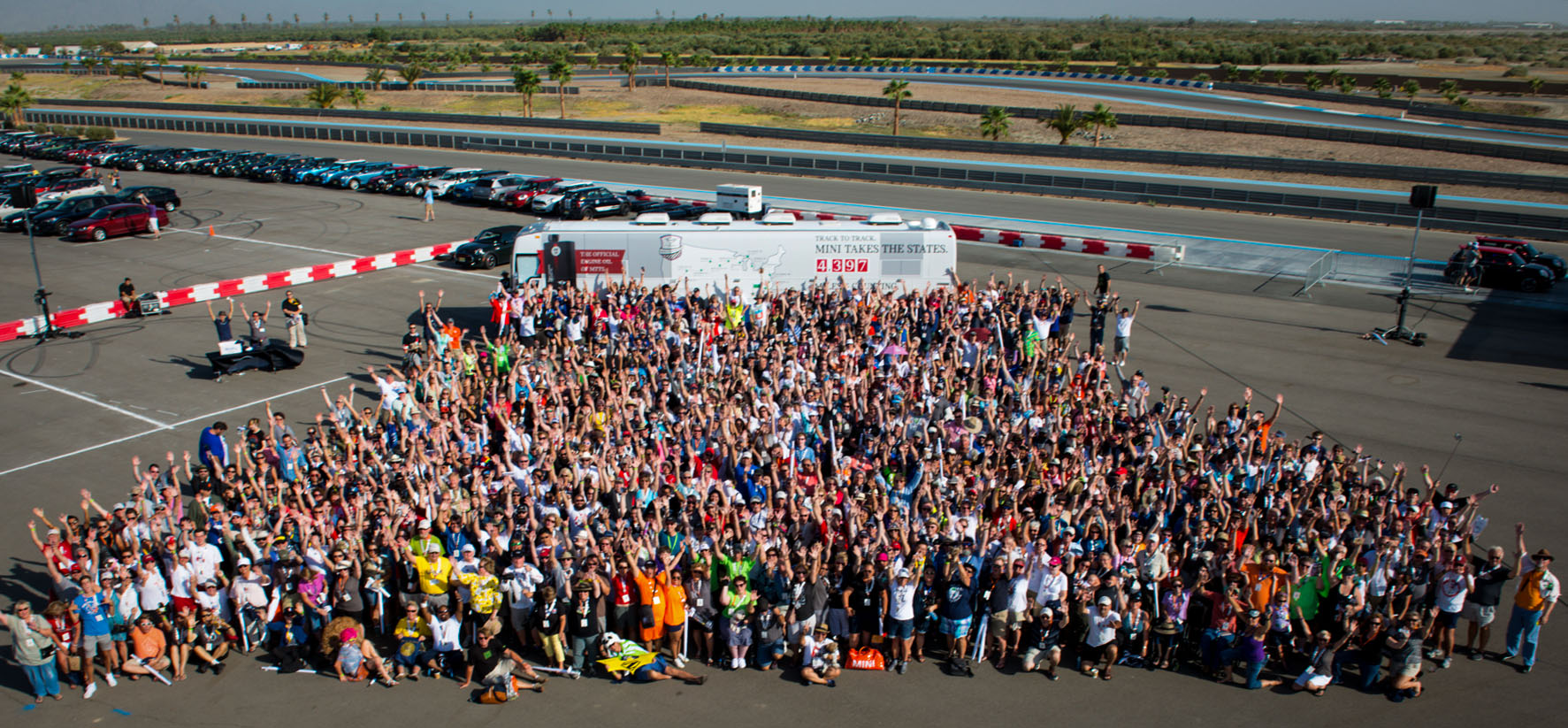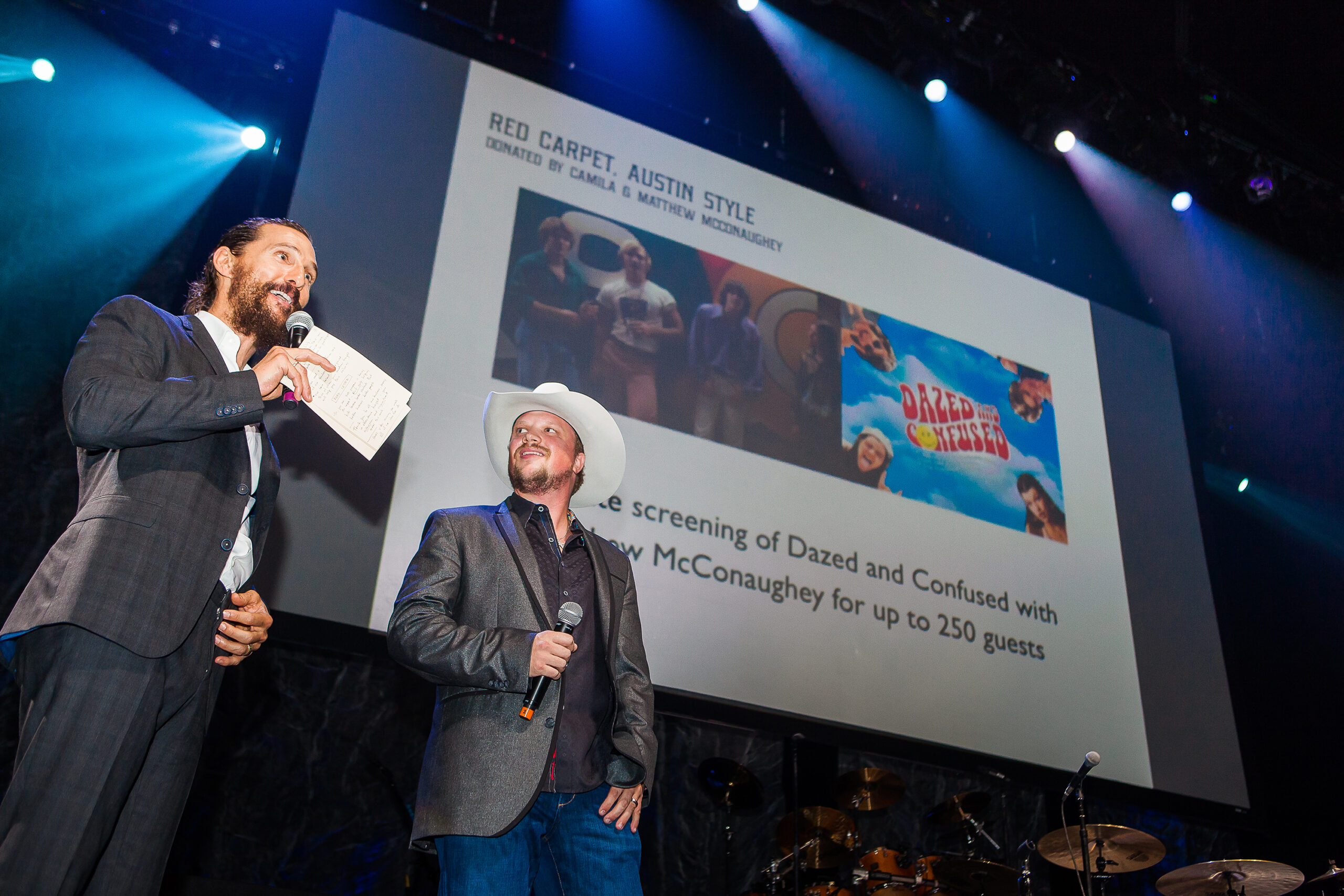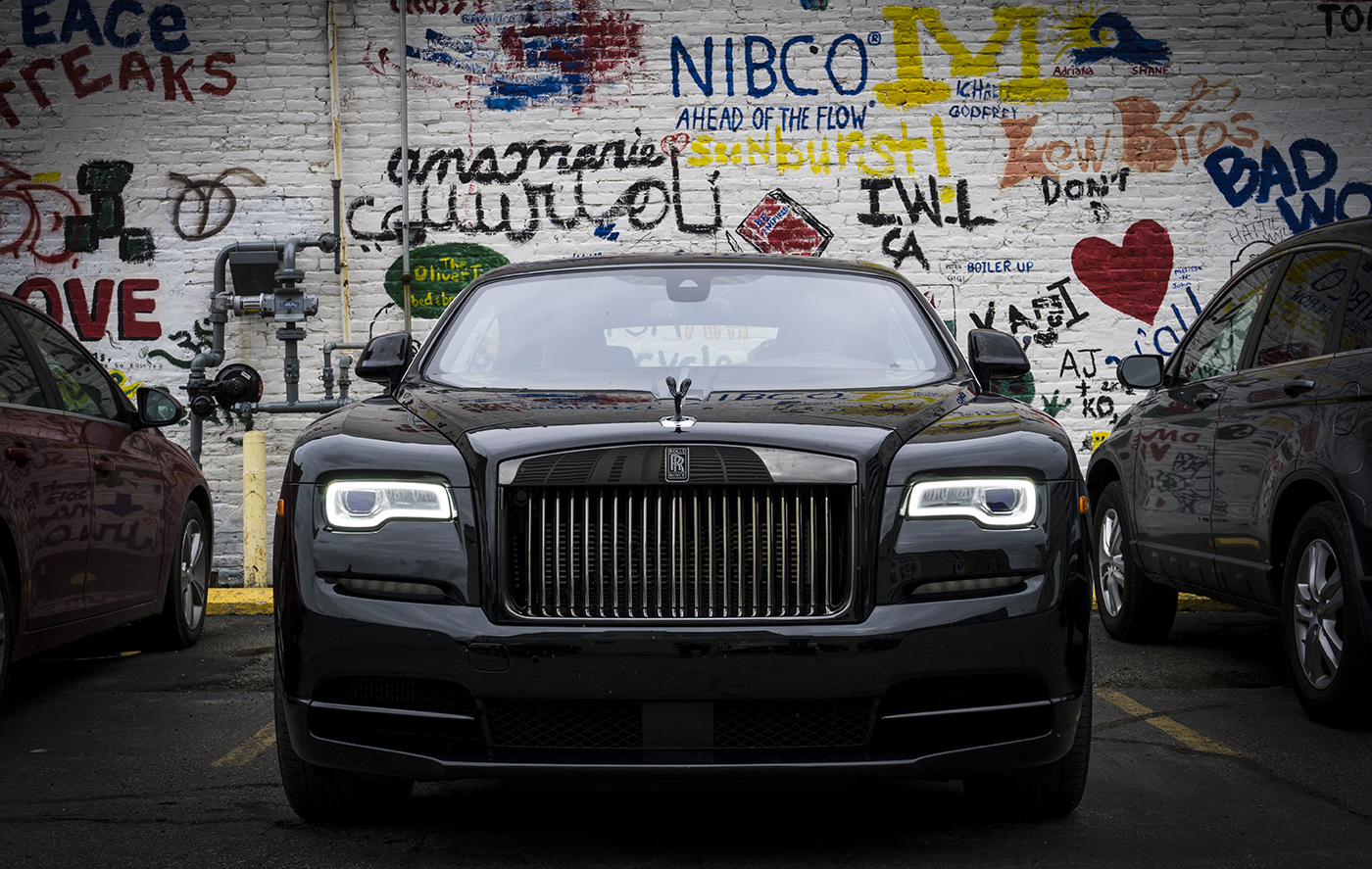Road Trip: On the Tamiami Trail of Bob Dylan and Pablo Picasso in a Camaro Convertible
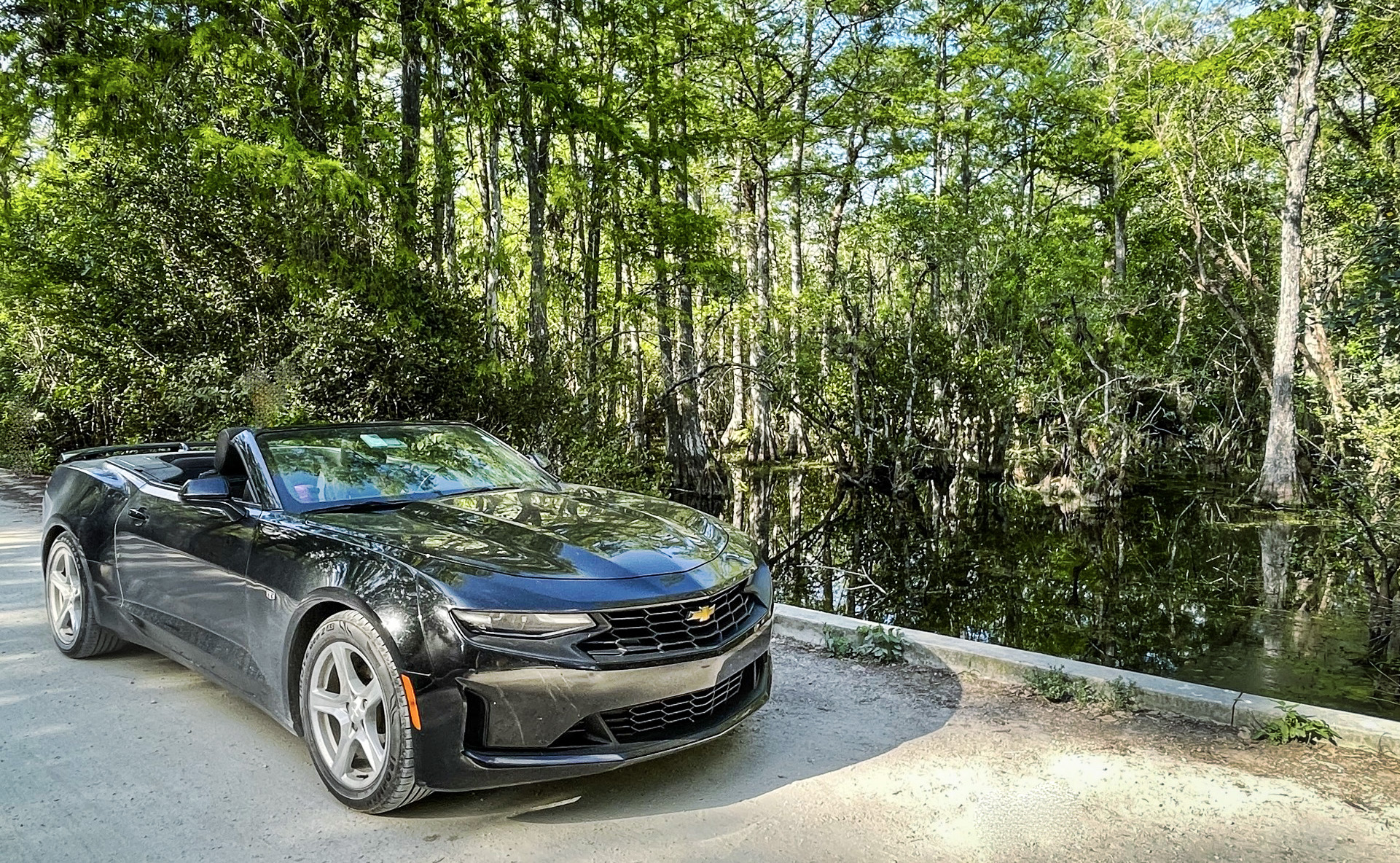
Most of the people who leave Wisconsin for Florida over spring break go for the beaches and night life. I go to rent a Camaro convertible to drive through the Everglades from Miami to St. Petersburg and back for unique exhibitions on the work of two of the twentieth century’s most important, influential and ever-changing artists – Bob Dylan and Pablo Picasso.
And, yeah, maybe a morning or two on the beach. Did I mention I live in Wisconsin?
“Bob Dylan Retrospectrum,” at Florida International University’s Frost Museum of Art closed April 17, reveals that the greatest singer-songwriter since Homer is also highly accomplished in oils, acrylics and ironwork. Smaller than the overwhelming exhibition which premiered in 2019 at the Modern Art Museum in Shanghai, it’s the largest exhibition of Dylan’s artwork ever staged in the United States and boasts a new series of acrylics Shanghai never saw – “Deep Focus,” 34 gritty, vibrant images taken directly from movies.
“Picasso and the Allure of the South,” at the Dali Museum until May 22, highlights how Picasso’s sojourns in the mountains and on the coasts of southern France and northern Spain so influenced his revolutionary art, especially the birth of Cubism. About half of the 79 works, spanning 1909-1972, have never been seen in the United States.
“Retrospectrum,” curated by MAM’s Shai Baitel, is expected to move on to other, yet unnamed, museums. The Dalí is the only venue worldwide to present this Picasso exhibition, curated by the museum’s chief curator, Dr. William Jeffett.
And a fine American muscle car for the highways and byways between them. With only one near-disaster.
Landing at Miami International at 2:30 Thursday, I needed to hit the highway out of town as soon as possible, before the late-afternoon traffic became overwhelming. The unified car rental center was a bit of a hike, and a tram away, but my workouts paid off and I got to the Budget counter ahead of the pack. A few minutes later, I was checking out a sleek black 2020 Camaro LT 1 convertible, mine for six days for $679.99.
It was a sharp-looking ride, but there were some problems right off the bat. With no manual or operational information of any kind, I had to spend some time figuring out how some things worked. Thankfully, the control to lower the canvas top was obvious and fast – and the sooner I got the top down, the quicker I could get rid of the stale smell of cigarette smoke. I gave the half-empty pack of Winstons which was still in the center compartment to the attendant as I left the garage.
The trunk was a bit problematic – only 9.1 cubic feet with the top up, 7.3 with it down. So my suitcase rode shotgun. The inside is equally skimpy on storage. And, no surprise, the car is not family friendly; while the front seats are exceptionally comfortable, with nice lumbar support, the back seats have so little legroom they’re hardly functional.
The LT 1 has a good and useful rear-view camera and is otherwise well-equipped with standard technology and safety systems, but it lacks Adaptive Cruise Control, Lane Assist and other refinements found on the upper trims. Still, the Camaro overall has a five-star safety rating.
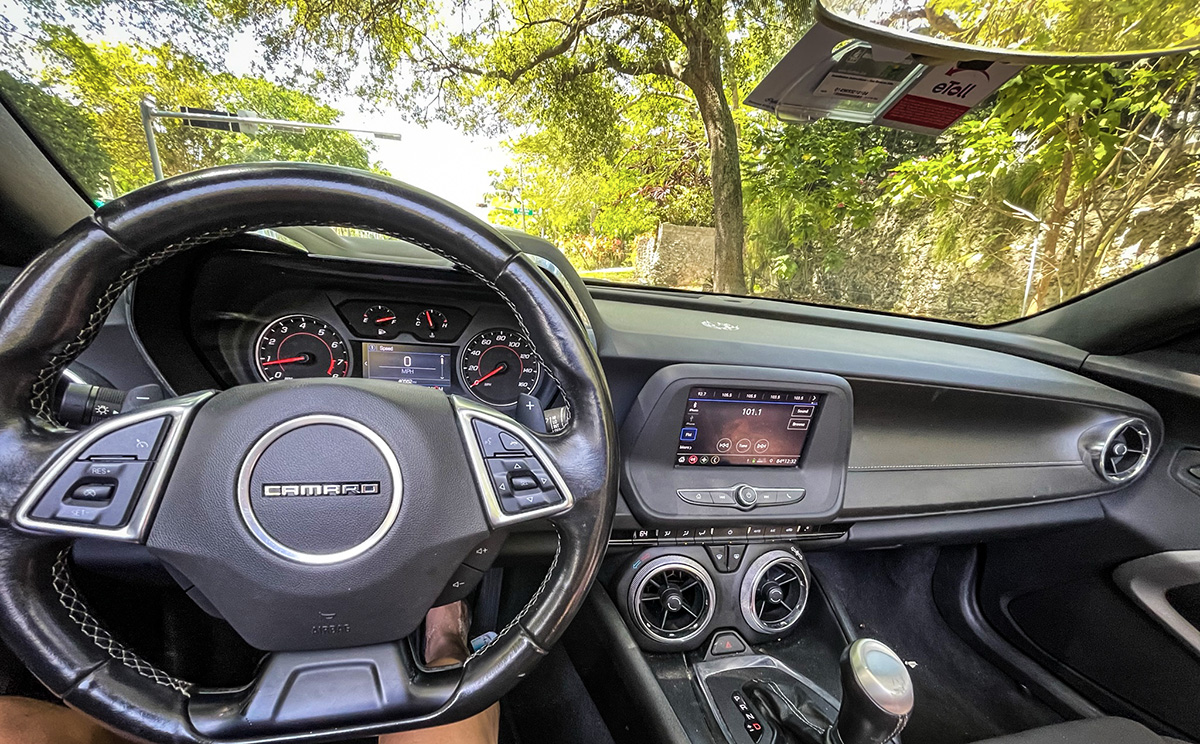
Cruising the terrestrial radio dial to get into the local rhythms and sounds, I used the responsive and well-positioned paddle-shifters to survive several miles of sprawl on SW 8th St./US 41 before entering the Everglades National Park area. As the Tamiami Trail began in earnest, I eased fully into the relaxed rhythm and headed for Sarasota, where in the early 1970s I went to the small private New College, now the public honors college of Florida. Omicron had killed our official reunion, scheduled for this weekend, but the hotel didn’t cancel the special reunion rate, and there were enough old friends still around, so Sarasota stayed my staging city for phase one.
Little did I know that would offer an artistic encounter with another inductee in the Rock and Roll Hall of Fame — Robert Maplethorpe and Patti Smith: Flowers, Poetry and Light, a novel exhibit at the Marie Selby Botanical Gardens just south of downtown,
Leaving most of the Everglades tourism for my return trip three days later, I made only a few stops in the Big Cypress National Preserve and headed west through the mosaic of prairies and tree islands.
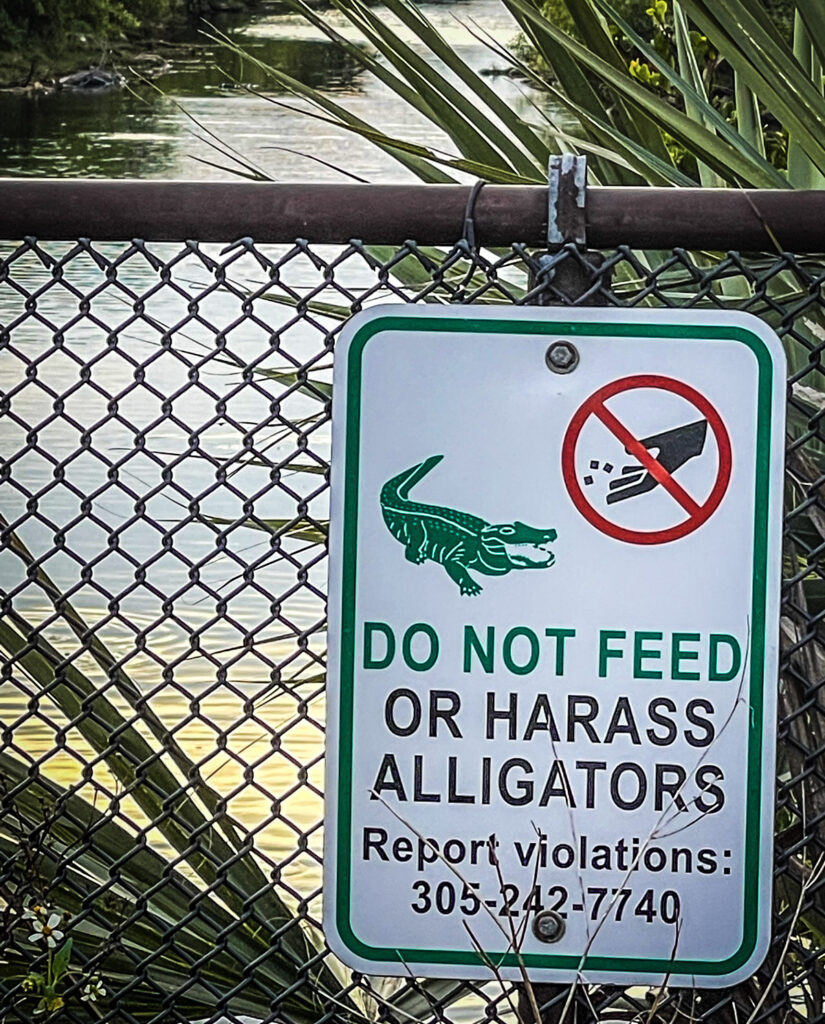
After 100 miles or so of almost unblemished nature, I couldn’t bear the thought of two hours of buildings and neon on the urbanized US 41 from Naples north. Besides, it was time to see how much muscle this muscle car had. As Dylan said in his 2014 Super Bowl commercial for the Chrysler 200, “We believe in the zoom and the roar and the thrust.” So I cut over to I-75 to let the 6.2 liter turbocharged V-8 do its thing, which it did in a very satisfying manner.
It was also time to fire up the Apple CarPlay for my playlists, pumping out through six speakers. The sharp seven-inch touchscreen infotainment display, which also featured Android Auto™ integration, Bluetooth® connectivity, On Star services and a Wi-Fi hotspot, worked seamlessly. And the USB port in the center compartment came in very handy; the cigarette lighter, not so much.
As I pulled off the interstate 90 happy highway minutes later and headed for my hotel, it began to rain. Although my own Lexus IS 250C convertible won’t let me operate the hard-top in drive, the Camaro’s soft top can be raised or lowered while moving, up to about 25 mph.
Friday morning, I learned that the Sarasota/Bradenton has an unusually high number of bad drivers and bad doctors. How else to account for the extraordinary number of billboards from ambulance-chasing attorneys I saw heading up to St. Pete? Thankfully, I soon left them behind for the approach to one of my favorite bridges, the graceful Sunshine Skyway. At 3,865 pounds, the Camaro seemed heavy enough that the “Danger – High Winds” warning didn’t bother me too much.
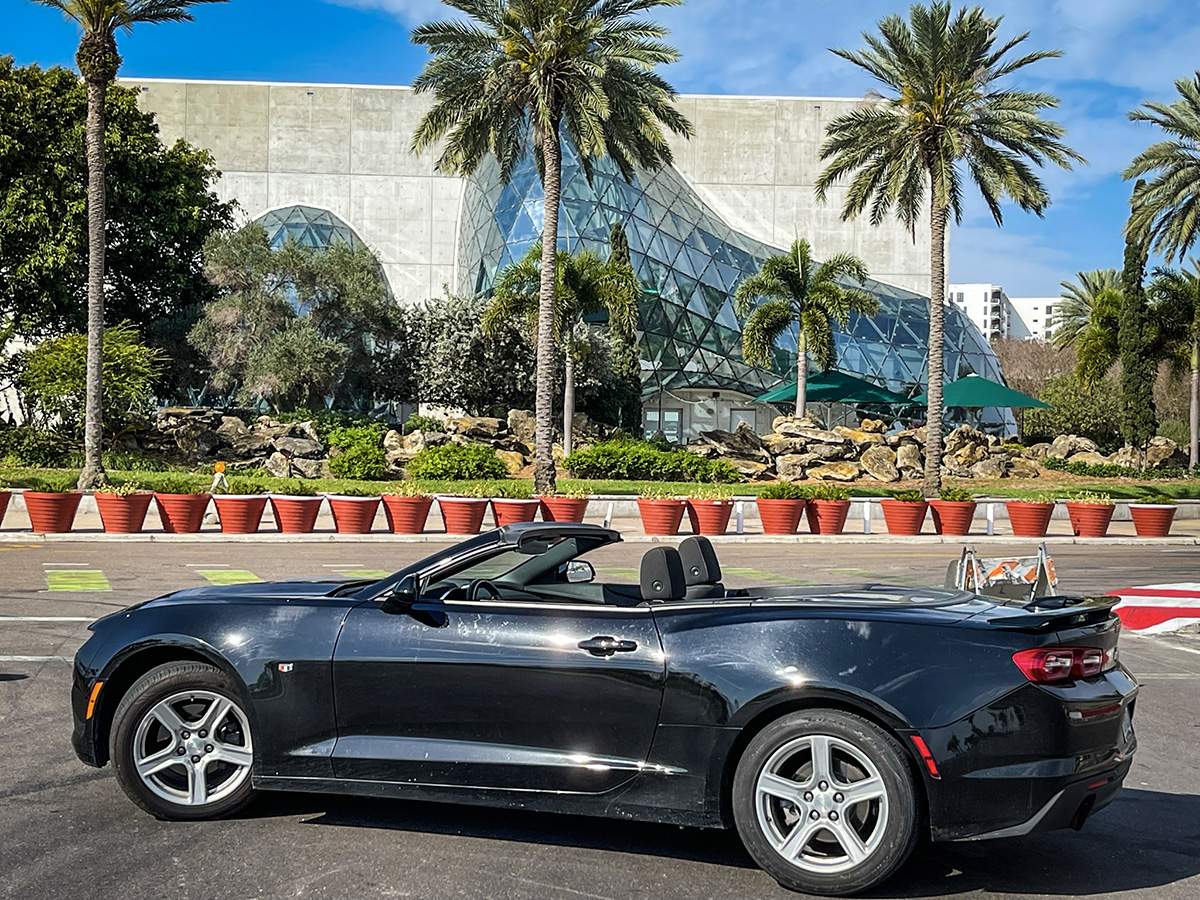
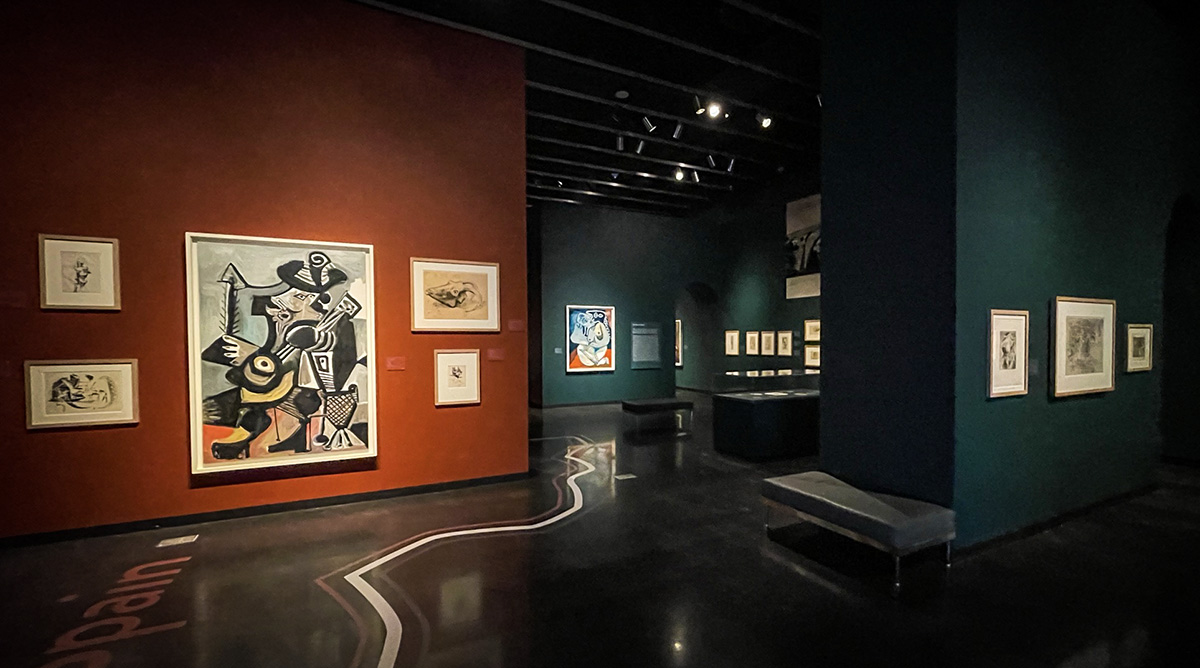
“Picasso and the Alure of the South,” organized in collaboration with the Musee national Picasso-Paris, makes the case that place was critical in several stages of Picasso’s work, especially the birth of Cubism.
It was in the hilltop town of Horta de Ebro in southern Catalonia in 1909 that he created some of the seminal works of “Analytic” Cubism by transforming buildings and landscape into a series of geometric shapes seen from varying viewpoints. Among such works here, the monochromatic ink The Reservoir at Horta and the colored oil The Oil Mill.
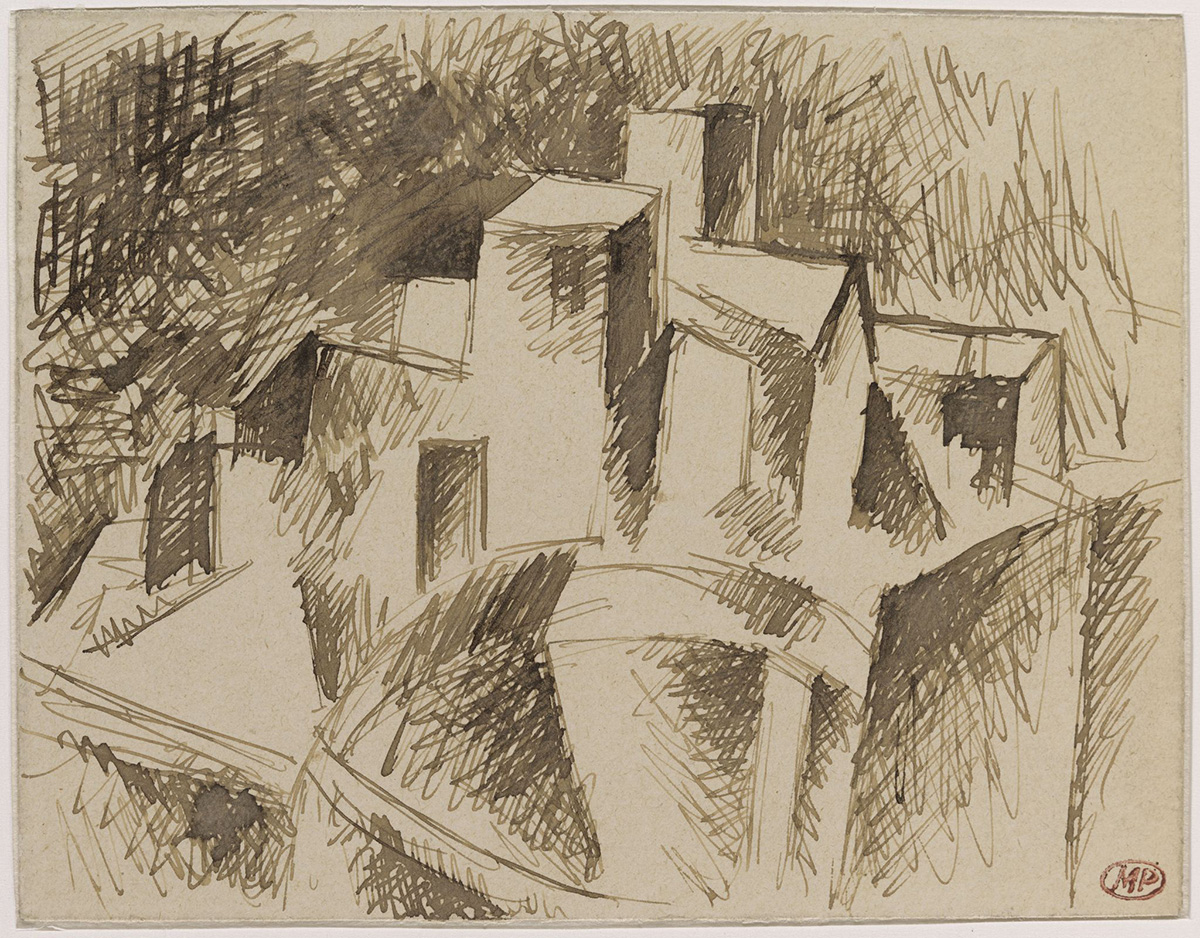
It was during Picasso’s sojourns in the nearby border town of Ceret, 1911-1913, that his fascination with collage marked the turn to “Synthetic Cubism.” Ceret’s spectacular views in the foothills of the eastern Pyrenees helped make it the center of the burgeoning Cubism movement, and the exhibition has several representative works, most notably the paper, pastel, charcoal and crayon Landscape at Ceret, from 1913.
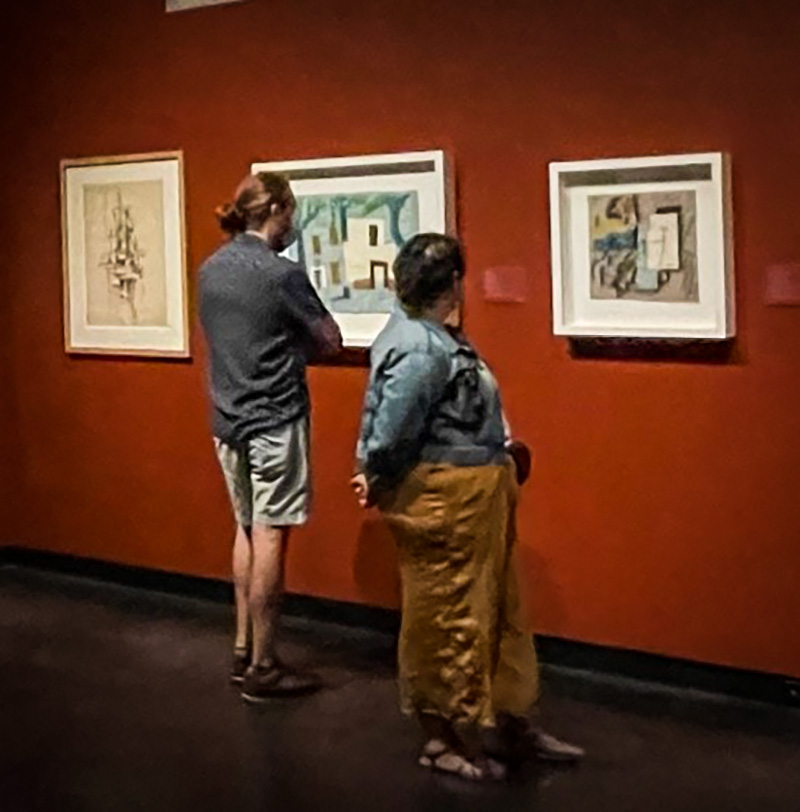
But just as Picasso and his Cubist colleagues were turning the art world upside down, the world stuck back by going to war. And suddenly anything Avant Garde was considered Germanic, a culture the French were understandably canceling. So Picasso, who in 1918 married the Russian ballerina Olga Khohklova and began traveling in high society, made the shocking switch to conventional portraiture – albeit with a bit of a twist. His 1918 neoclassical Portrait of Mrs. Rosenberg and Her Daughter, commissioned by his soon-to-be new art dealer and seen here for the first time in the United States, does neither mother nor her pudgy child any favors.
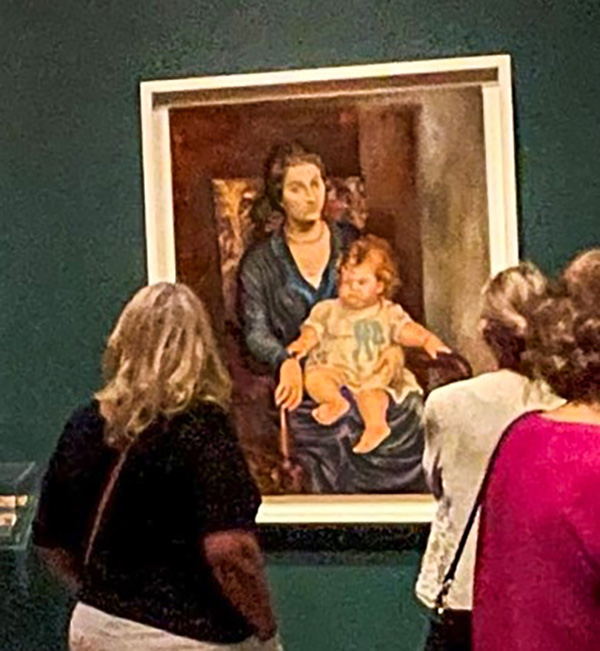
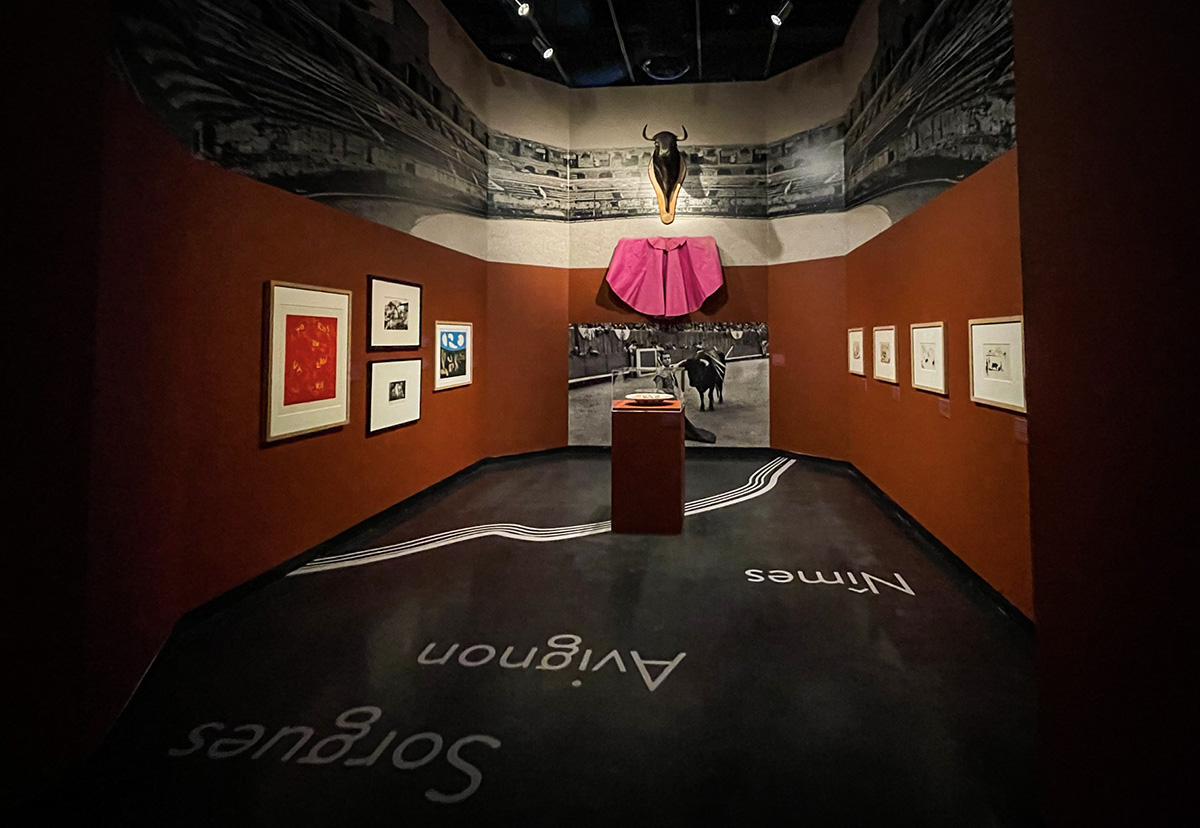
Moving through through the exhibit, the names of the towns on the floor give you the signposts of Picasso’s travel. Here, they lead to some historic bullfighting towns in southeast France, part of the coverage of Picasso’s fascination with that particular pastime.
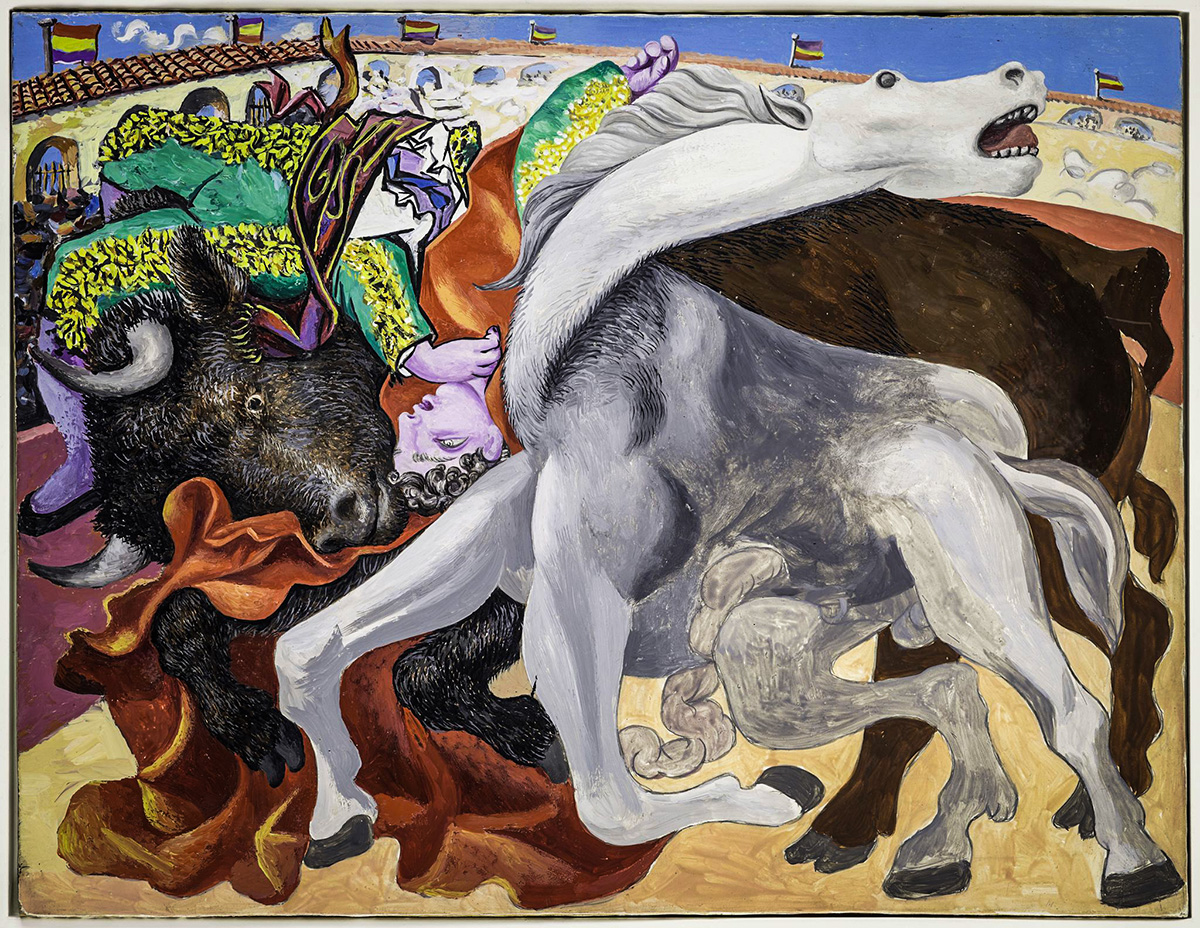
Numerous display cases offer intriguing correspondence, photographs, postcards and ephemera. I always figured Picasso was the kind of man to entertain visitors wearing a silk dressing down, seated beneath a framed portrait of himself.
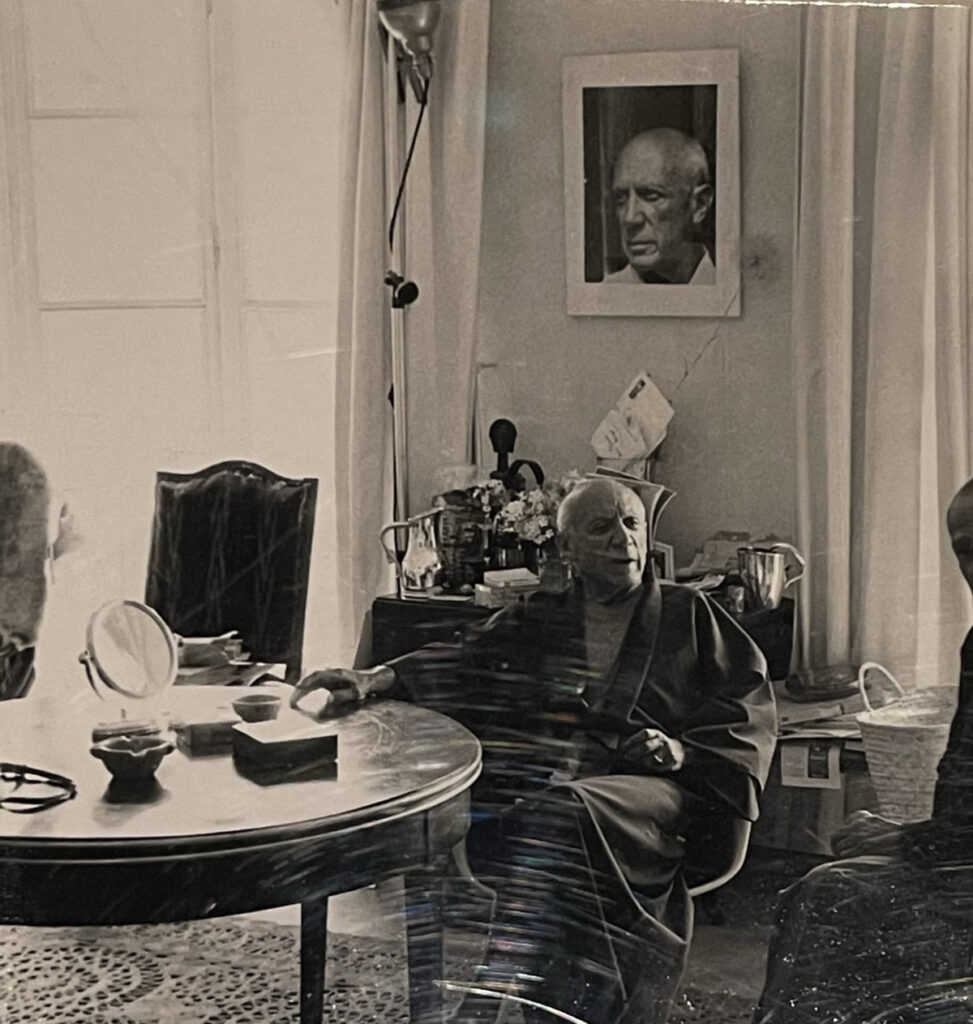
The exhibition concludes with Surrealism and Beyond, represented by several bizarre works spanning decades of creativity.
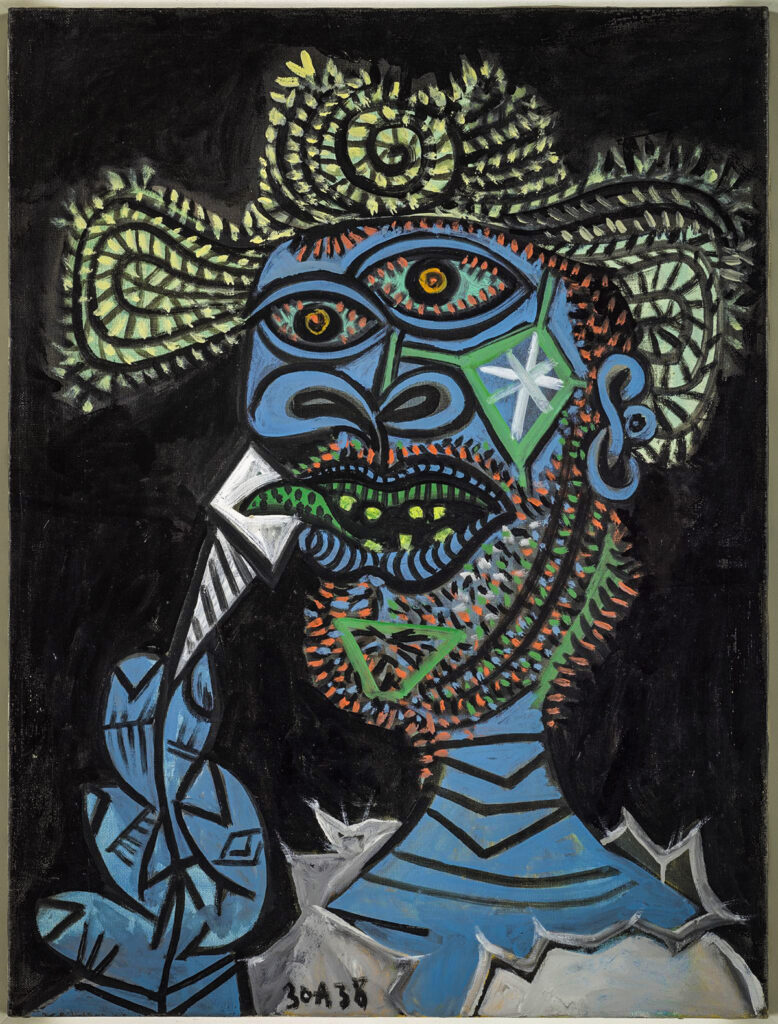
There’s a very cool coda to the exhibition – the opportunity to use the museum’s artificial intelligence program to create a self-portrait a la Cubism. Here’s mine:
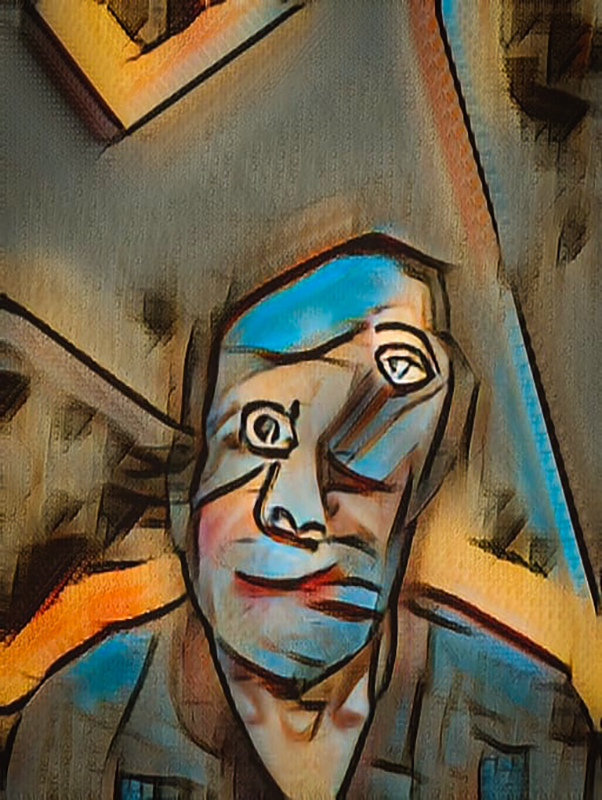
Back in Sarasota, I caught a lovely sunset by the bay behind College Hall, which was originally the mansion of circus magnate Charles Ringling (It’s quite a campus – back across 41, our main dorms, classrooms and student union were designed by I.M. Pei). Then I joined some alums for a restaurant’s outdoor open mic and performed dramatic renditions of two Dylan lyrics, which people seemed to enjoy.
I assumed I had left the phrase “wind chill” back in Wisconsin, but there it was in the weather forecast for Saturday, along with a tornado warning. Thankfully, I never had to put the car into the “snow-and-ice” mode but could stick with the comfortable touring or the punchier sport mode.
Sunday was nice enough for all-day outdoor activity, starting with the Mapplethorpe/Smith exhibition.
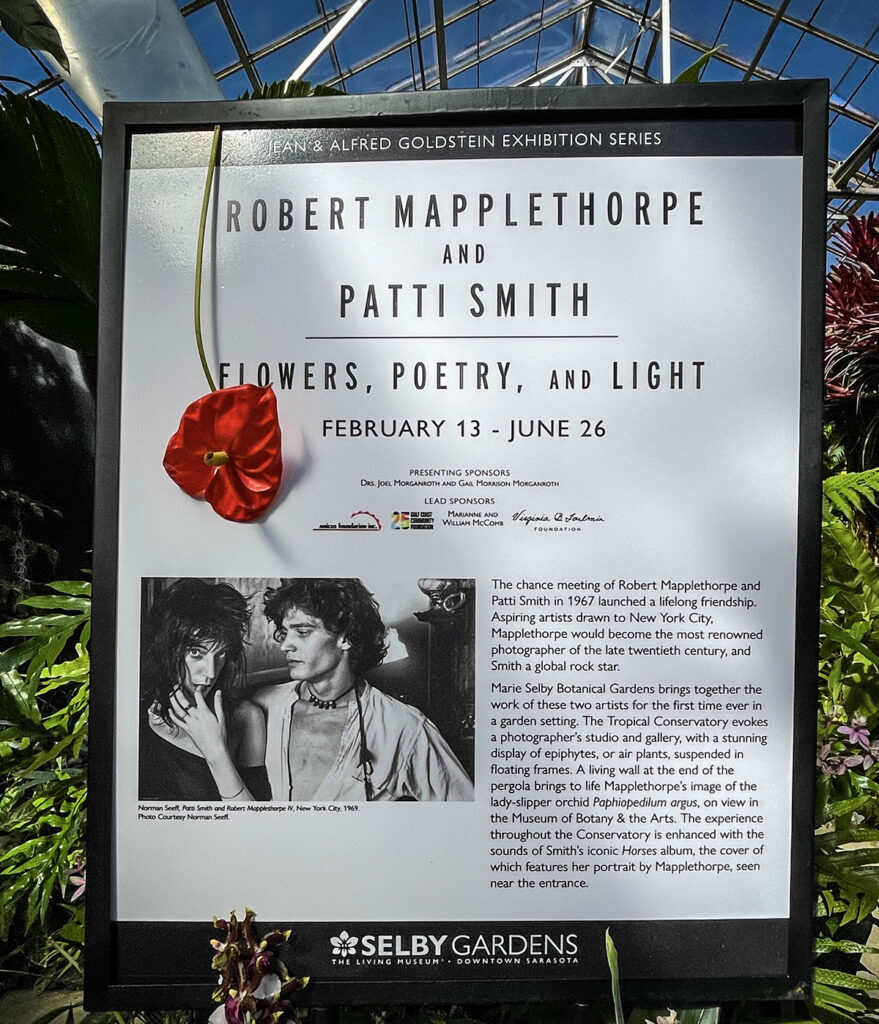
Notwithstanding his notoriously sexual and sadomasochistic photographs, and her early (and enduring) renown as a punk rocker, the two also took deep artistic inspiration from flowers and nature. Spread over the Selby’s 15 acres, the exhibit melds horticultural installations inspired by their work, nature-inspired photography and archival images into a captivating living museum.
Naturally, there’s audio, both from Smith’s first album, Horses (for which Mapplethorpe took the cover photo) and Smith’s audiobook reading of her National Book Award-winning memoir of her time with Mapplethorpe, Just Kids. The exhibit, which culminates inside the Museum of Botany and the Arts with candid photos of the then-couple plus half a dozen of Mapplethorpe’s exquisite flower photographs, remains on view through June 26, 2022.
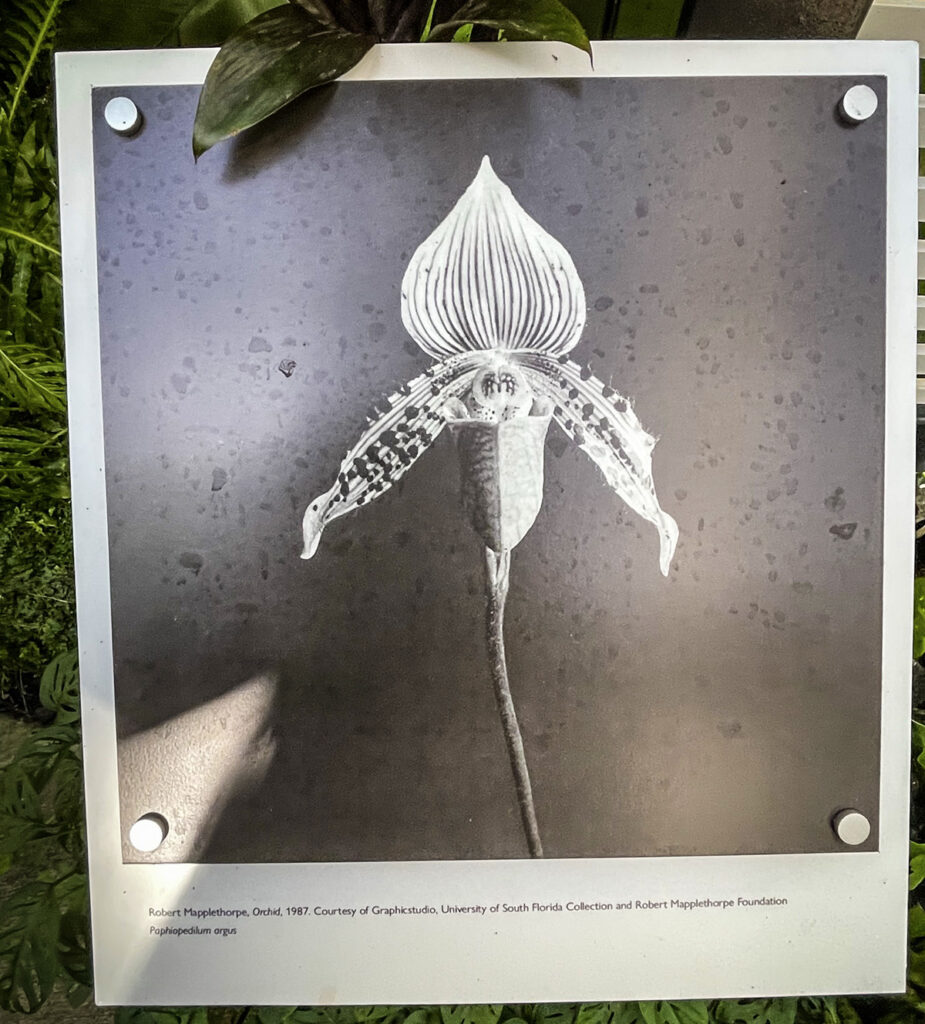
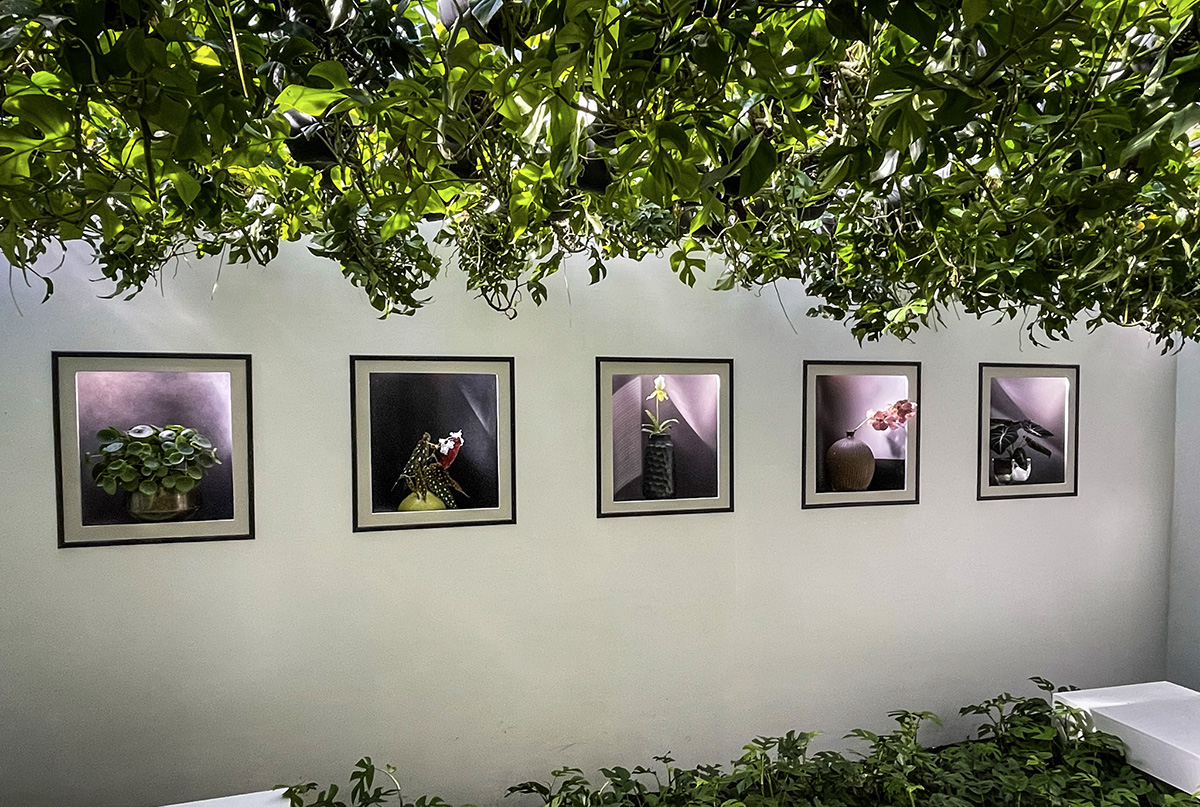
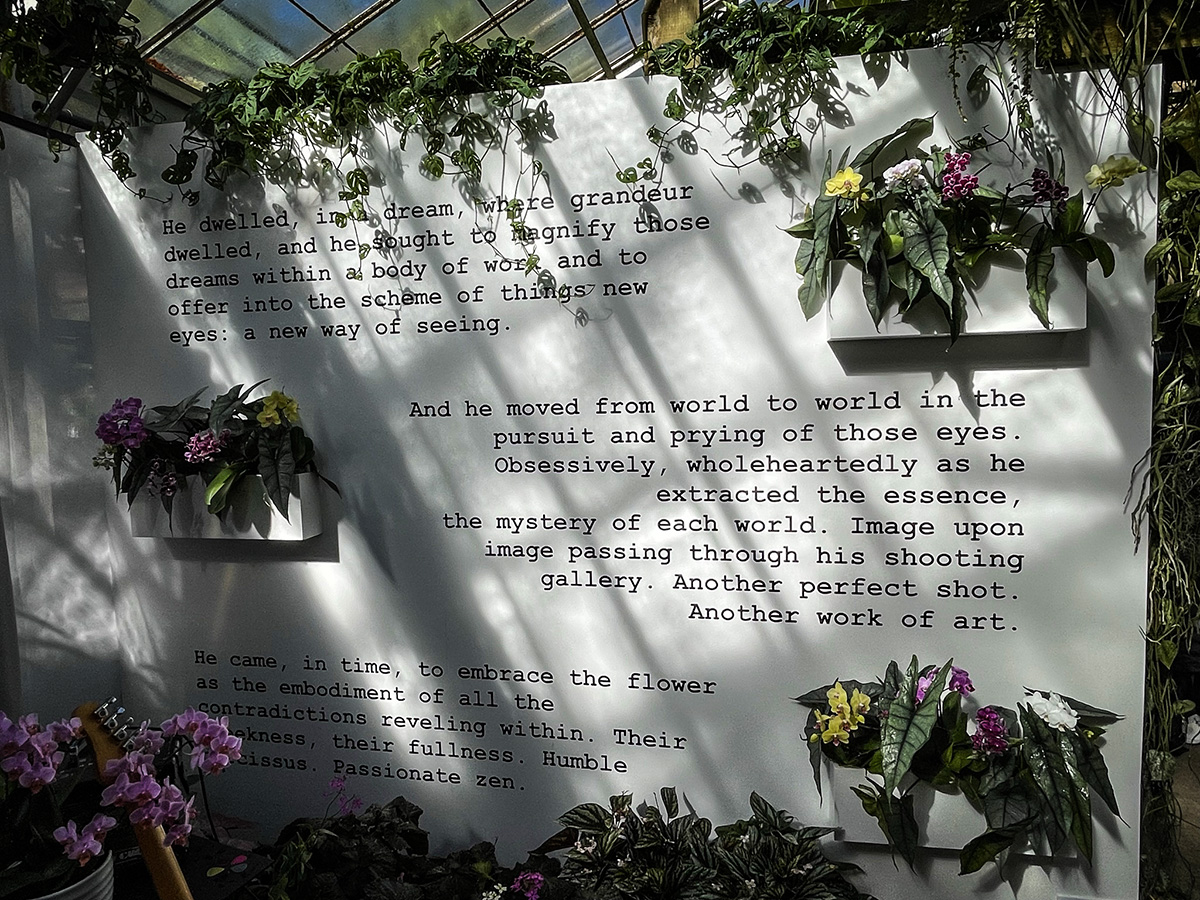
The installation has Smith’s full endorsement and participation – the day after I left, she did a 75-minute interview/reading/performance on the grounds, which you can view here.
After the Selby I headed straight for Siesta Key beach, which Tripadvisor this year ranks as the country’s second-best public beach. With sufficient sunscreen and a wide-brimmed hat, I did about 5 miles up and down the white powder sand and stood for a while in the gently lapping Gulf of Mexico before heading back to campus for a sunset memorial for recently deceased classmates.
But a few minutes after leaving the parking lot, I realized I didn’t know where the key fob was. Not in my pockets, not in any of the storage compartments, not on the floor. I pulled over onto a condo’s private street; careful not to turn the engine off – lest I couldn’t turn it back on again – I combed the car from door to door and came up empty. Back to the lot to see if it was on the ground, or if it had been turned in; again, nothing. I raised the top a little, to see if the fob was somehow in the trunk; nope. Slowly panicking, thoroughly confused, and out of options I headed back to the hotel, trying to work through just how bad this could be.
The moment of truth would come when I parked, put the top up, and turned off the engine. If it started back up, I figured I’d be ok; if it didn’t, I had a big problem.
I took a deep breath and pressed the button. The engine roared to life.
But still no key fob. Puzzled, but no longer panicked, I got out and turned to close the door – and there it was, right on the canvas top. For some inexplicable reason, after I unlocked the door back at the beach, I tossed the fob onto the top before getting in and lowering it; all the while, the fob was safe in the canvas folds, tucked into the trunk.
I resolved to be more attentive, and cleaned up for the memorial and a wonderful dinner with some good friends.
Wanting to maximize my time in the Everglades, and put the Camaro back to its highest use, I headed for I-75 early Monday morning. Top down, engine humming, tunes rocking – a very satisfying marriage of man and machine. After ninety high-speed highway minutes, I slid over to US 41 just southeast of Naples; half an hour later I was parked at the Trail’s most accessible highlight – the Big Cypress Bend Boardwalk, in the Fakahatchee Strand Preserve State Park.
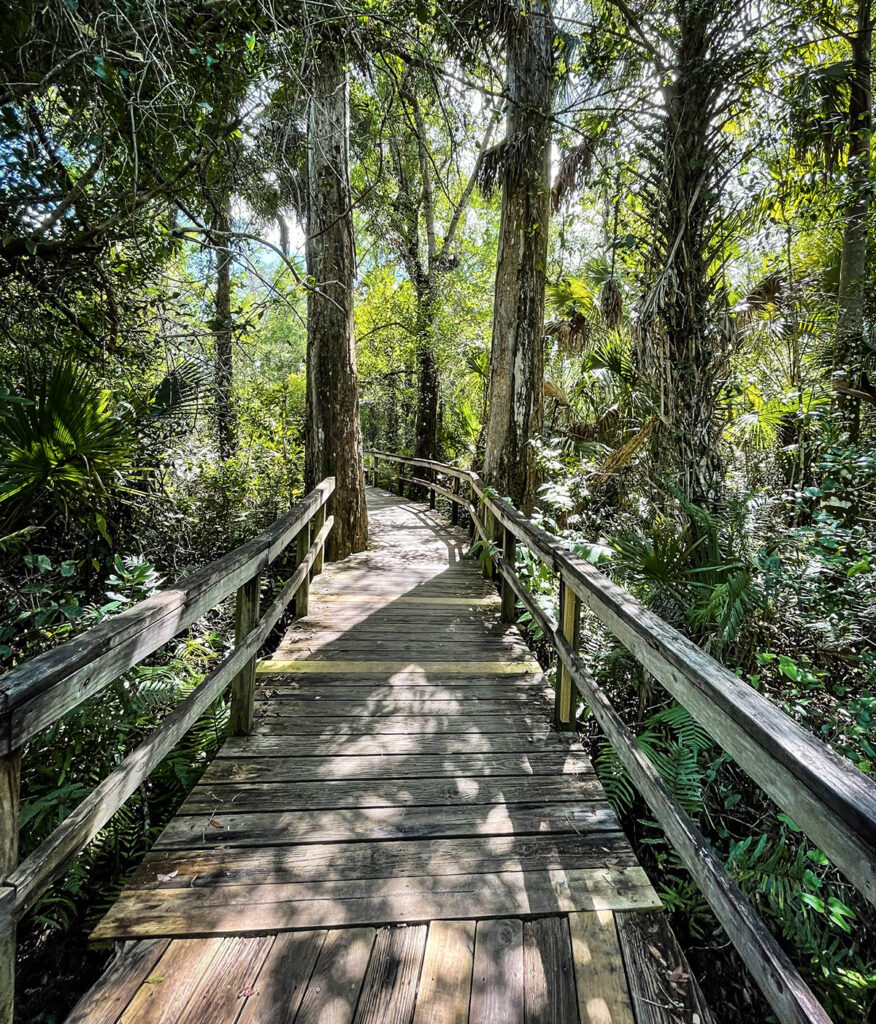
The 1.2 mile (roundtrip) walkway is but a fraction of the acre-preserve preserve, but it contains a notable natural landmark – a stand of virgin cypress in a strand that is otherwise cut over. It’s why this section of the swamp was made a registered National Natural Landmark in 1966.
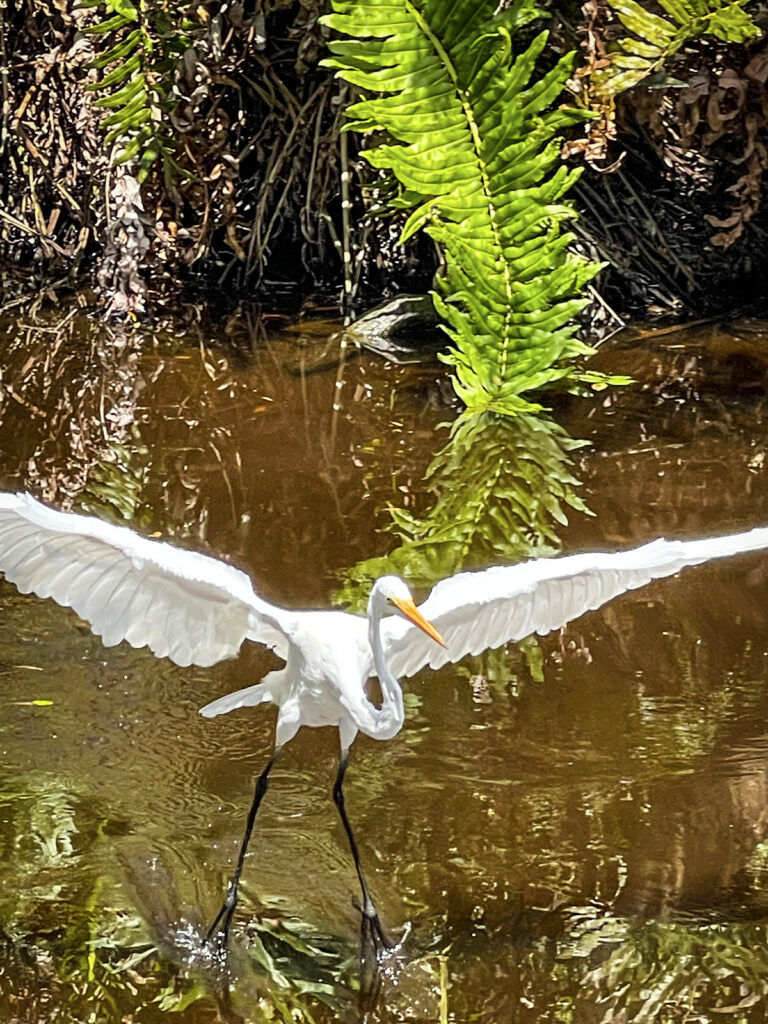
The Preserve’s top attraction is a few miles east, the 27-mile long Loop Road, filled with forests of dwarf cypress and pine, hardwood hammocks and, yes, more alligators.
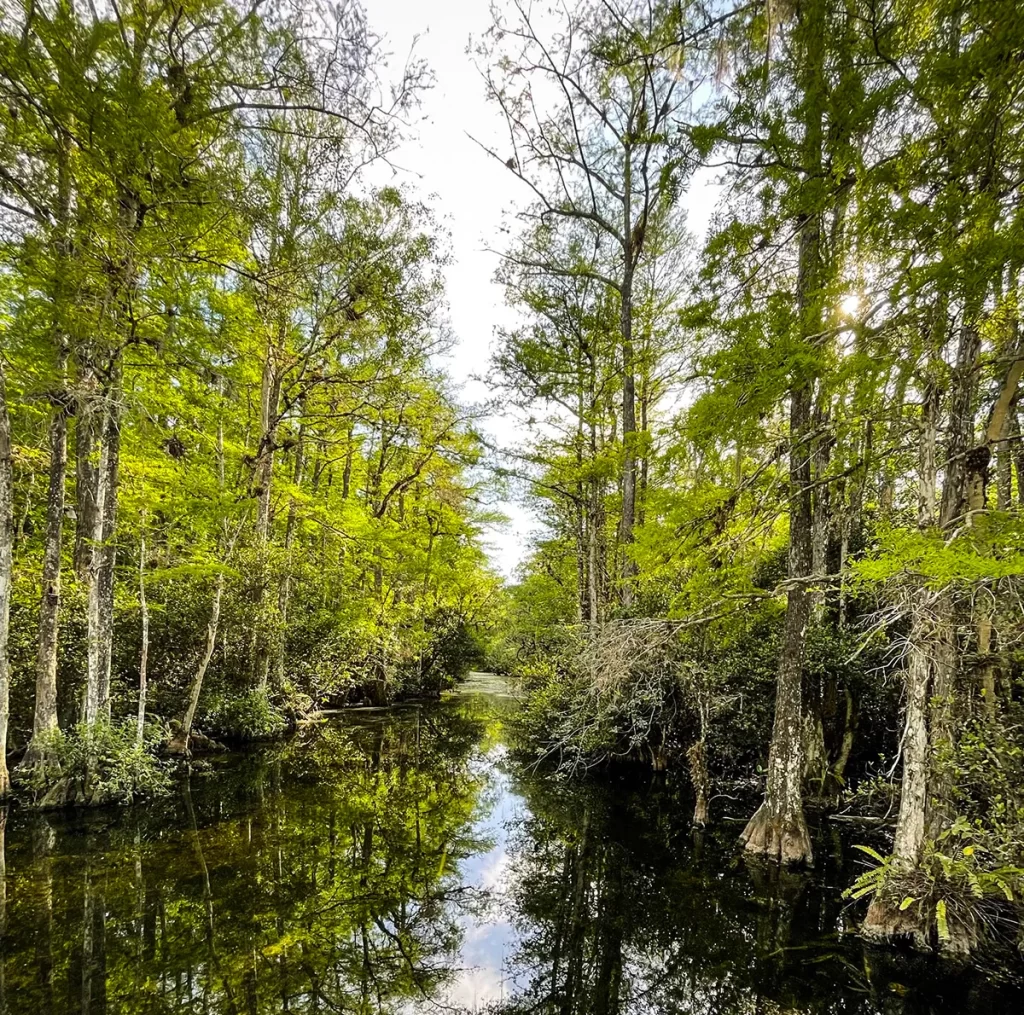
Staying at a chain hotel near the airport was fine for Sarasota, but wouldn’t do for this final leg. Instead, a private rental in an upscale hotel overlooking the ocean in hip and historic Coconut Grove seemed like the right play, and it was.
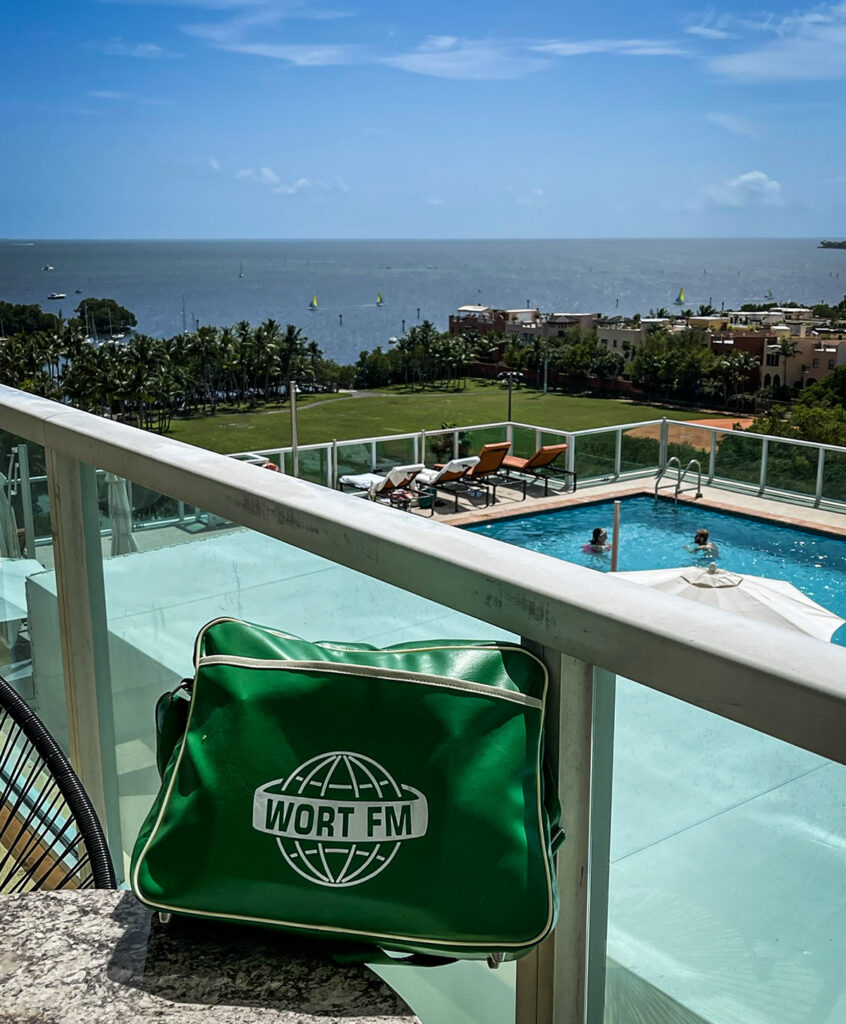
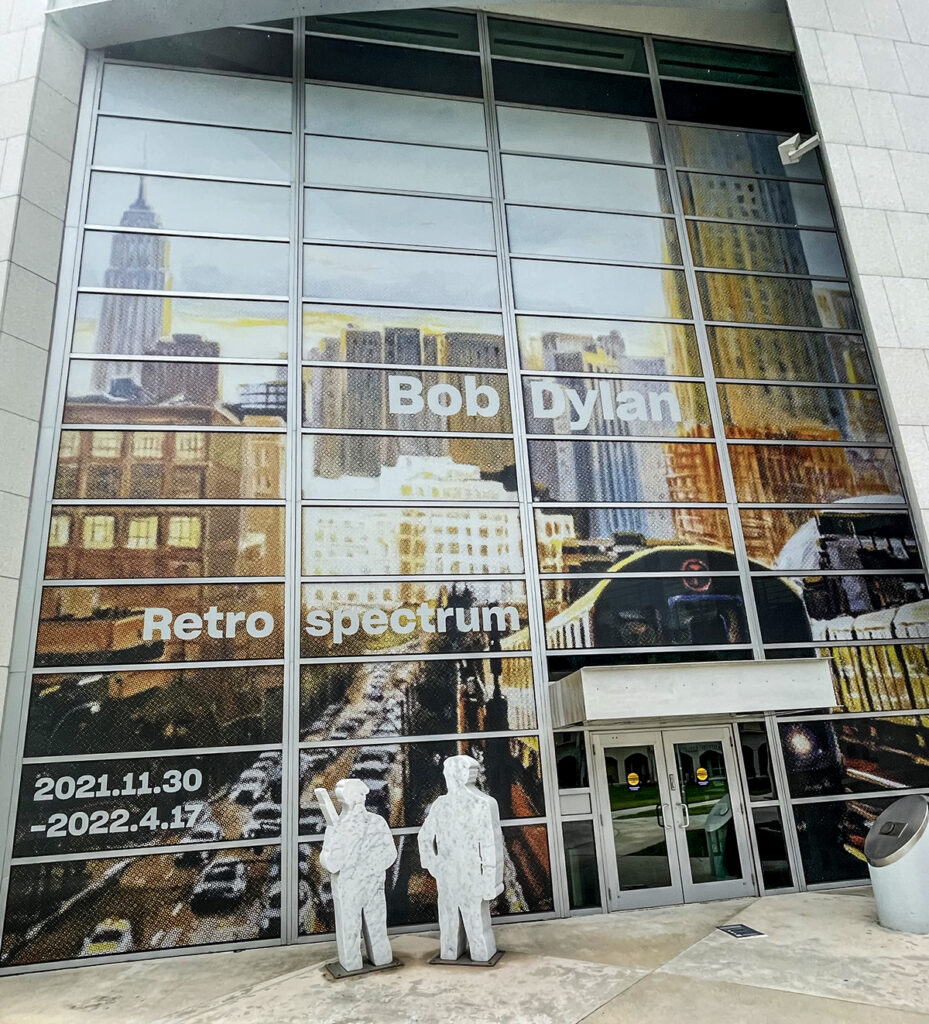
Tuesday finally brought the main attraction of the trip – Retrospectrum, a portmanteau which did not exist until Dylan coined it for the Shanghai exhibition.
It did not disappoint.
The 186 items showcase Dylan’s unique range and growing skill. He may not be the world’s best painter or the top welder, but it’s impressive that he’s as skilled as he is in such disparate media.
Arrayed in six galleries on the second floor, the artwork encompasses seven stages of Dylan’s artistic development; other than about two dozen drawings from 1973, all date from 2007 to 2021. It’s an astonishing output for a man who also recorded 6 albums (one of them with three discs) and performed 1,083 concerts during that period, and is now 80 years old.
The highlight is the world debut of “Deep Focus,” named after a technique in cinematography where nothing is blurred out. It’s an apt title for this neo-Ashcan collection, with images that Dylan says “try to highlight the different predicaments that people find themselves in. The dreams and schemes are the same — life as it’s coming at you in all its forms and shapes.”
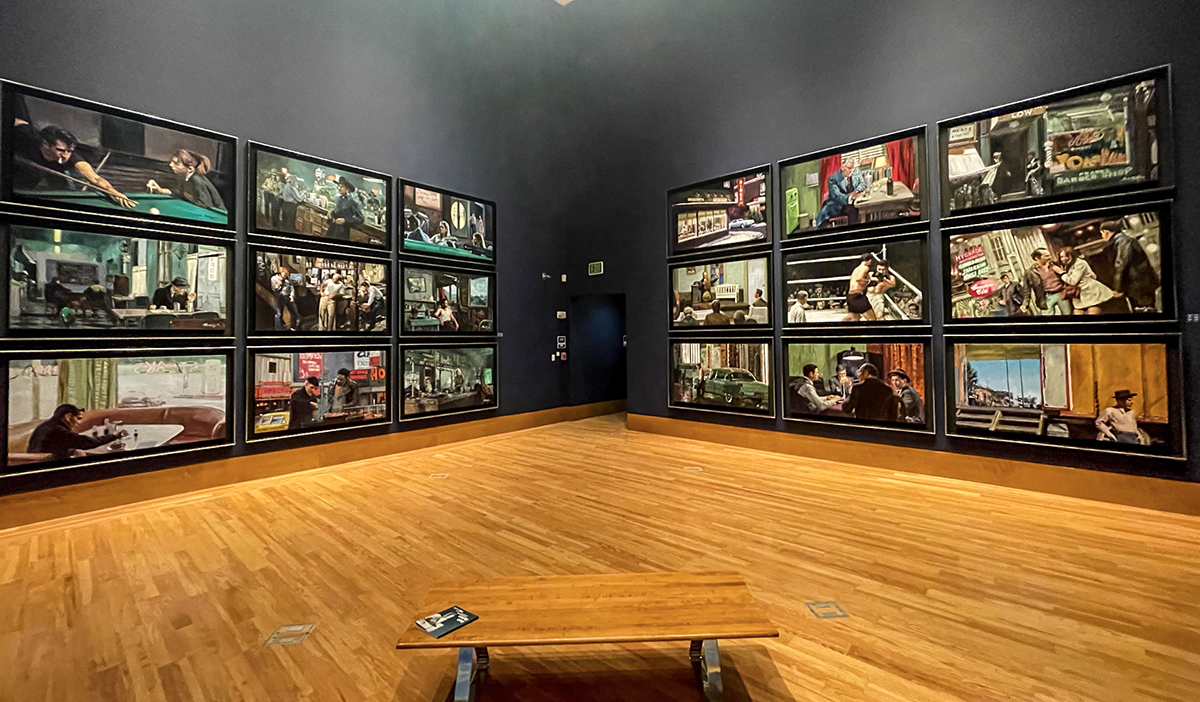
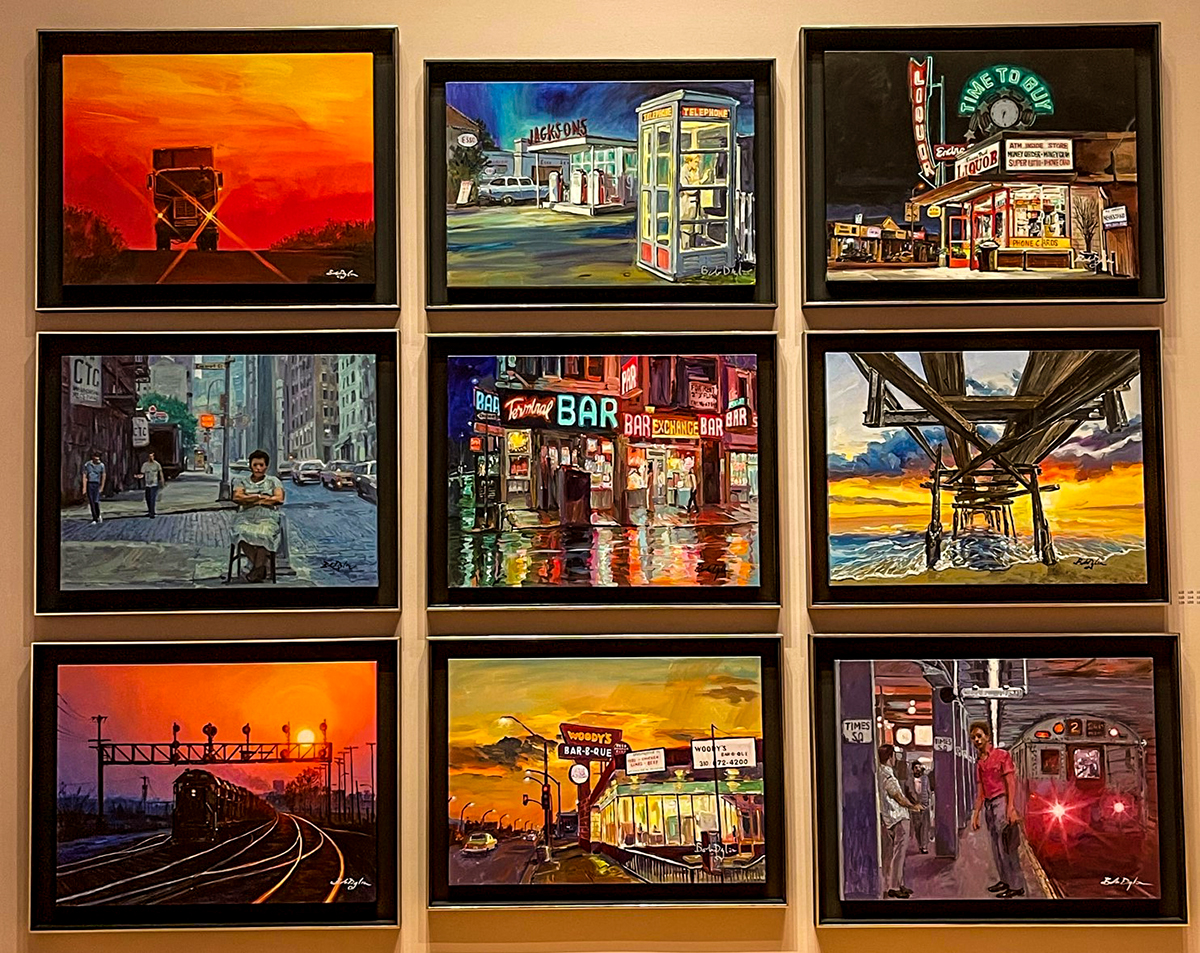
Born under the sign of Gemini, Dylan once wrote, “I fought with my twin, that enemy within,” and two recent stand-alone triptychs reveal a decidedly dual nature.
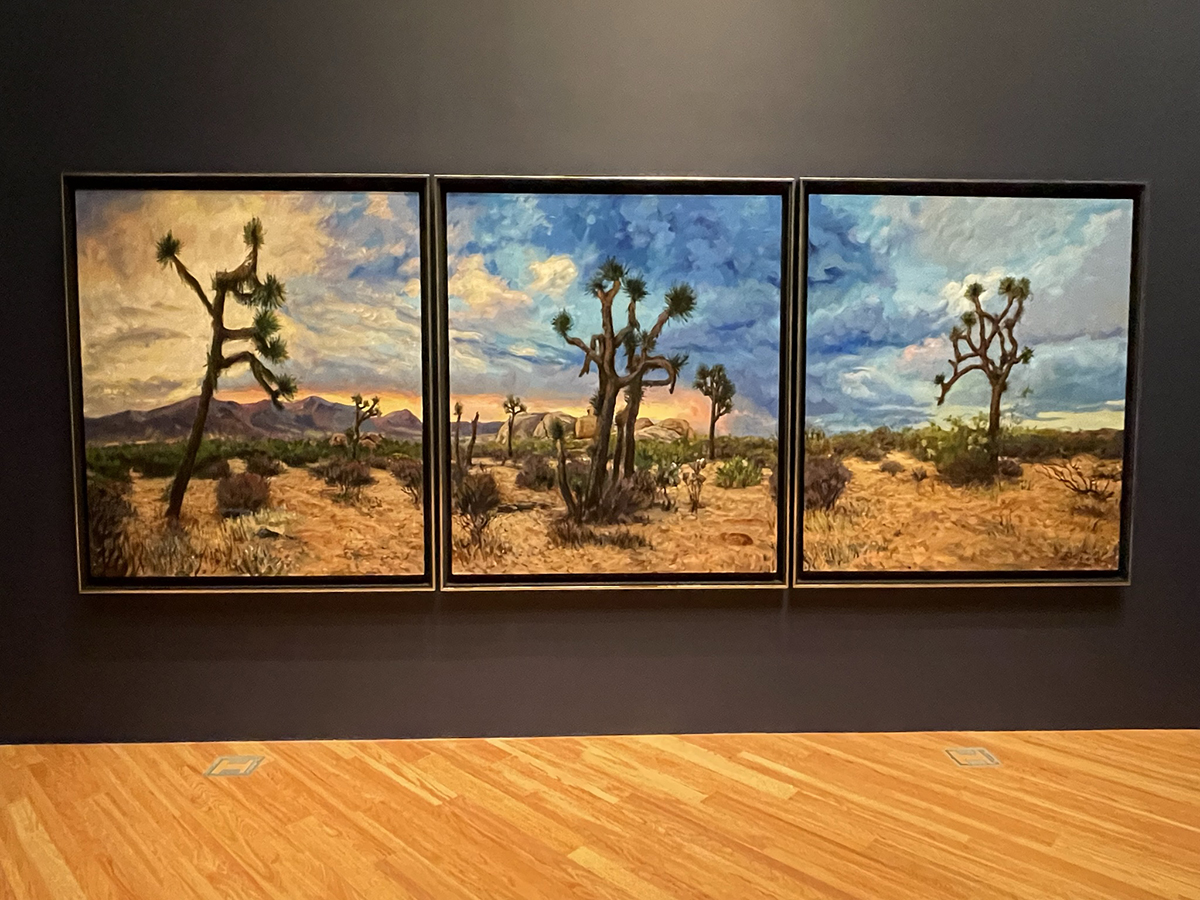
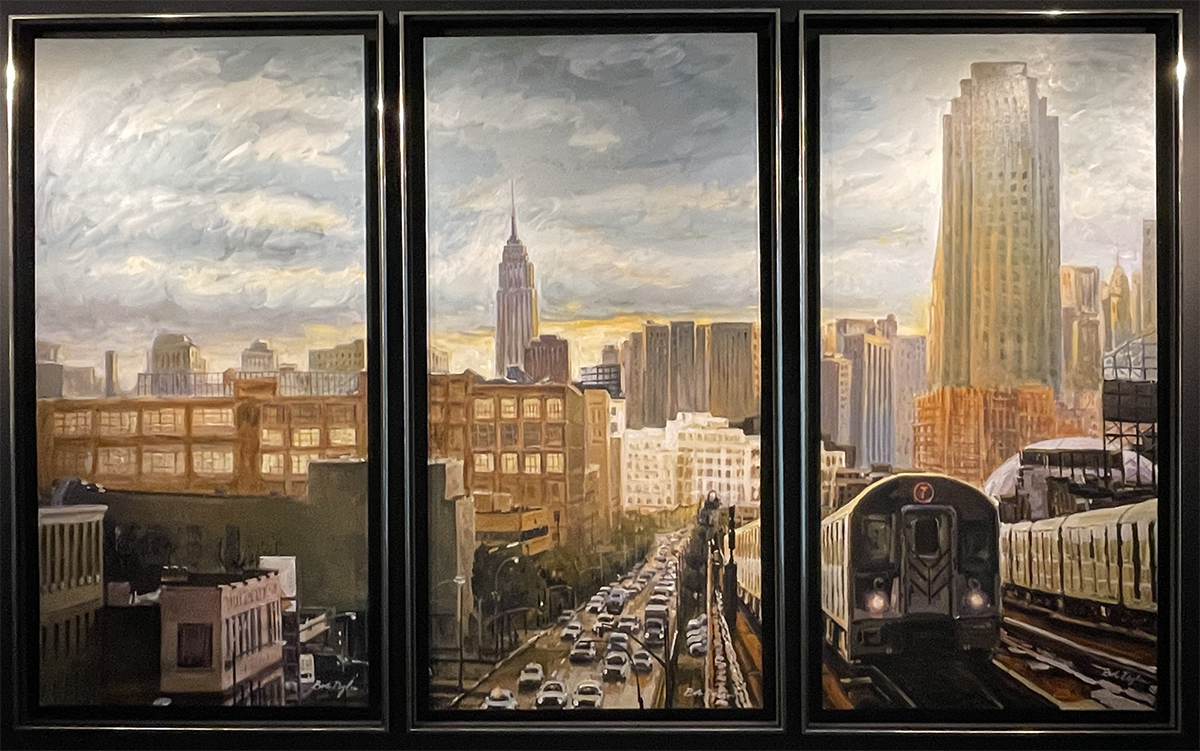
Although Dylan took some art classes in New York in 1974 from the painter Norman Raeben, the artistic impulse seems to have lain dormant until he started his so-called “Never-Ending Tour” in 1988. It was during the tours of 1989-1992 that he made a series of sketches published in 1994 as Drawn Blank – portraits, landscapes, interiors, still lifes, street scenes and nudes. Twelve years later, a German museum curator came upon the book and pitched Dylan’s management team on Dylan’s first-ever exhibition.
Dylan took it a big step further. In 2007, a year he performed 98 concerts on three continents, he digitally enlarged the drawings, transferred the scans, and created 320 paintings in watercolor and gauche, often several iterations of the same image. The Frost exhibition has a nice representation of this Drawn Blank Series, which premiered at Halcyon Gallery, London in 2008. Among the 29 works, three versions of “Train Tracks,” a main motif in the series.
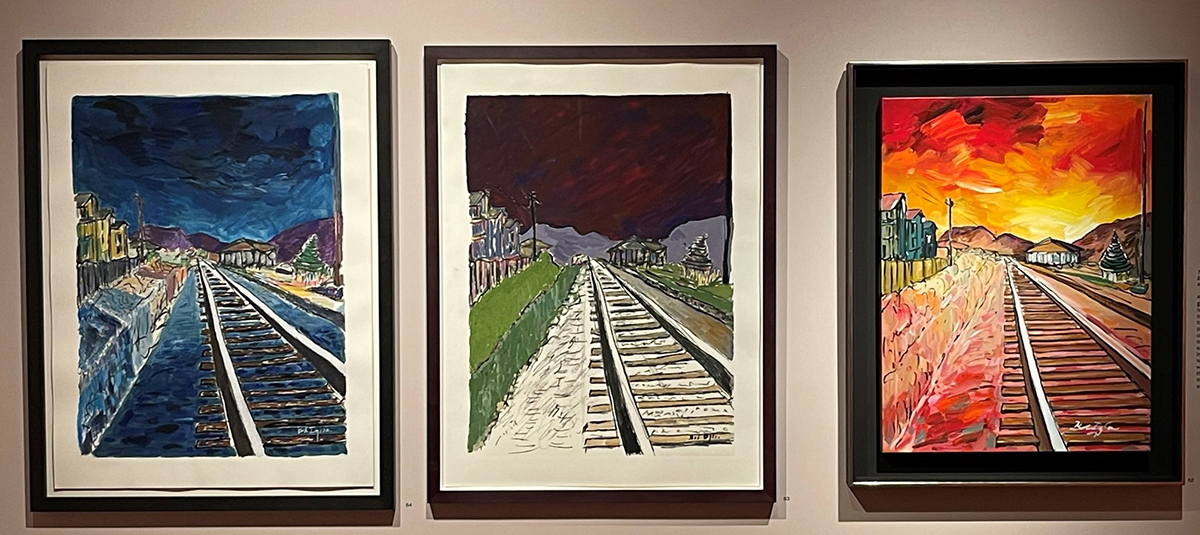
Asked by the Halcyon Gallery to paint American landscapes, he debuted the Beaten Path series in 2016. Focusing on the freedom of the open road and the detritus of American life, the title itself nods to the Beat generation (whose leaders Dylan name-checked in the elegiac “Key West” (Philosopher Pirate)” on 2021’s Rough And Rowdy Ways.) The series calls to mind another line from that Chrysler commercial: “You can search the world over for the finest things, but you won’t find a match for the American road … and the creatures that live on it.”
“I believe that the key to the future is in the remnants of the past,” Dylan says in the gallery guide, and many of the images are of places with a future long past – cheap motels and gas stations, dive bars and hot dog stands.
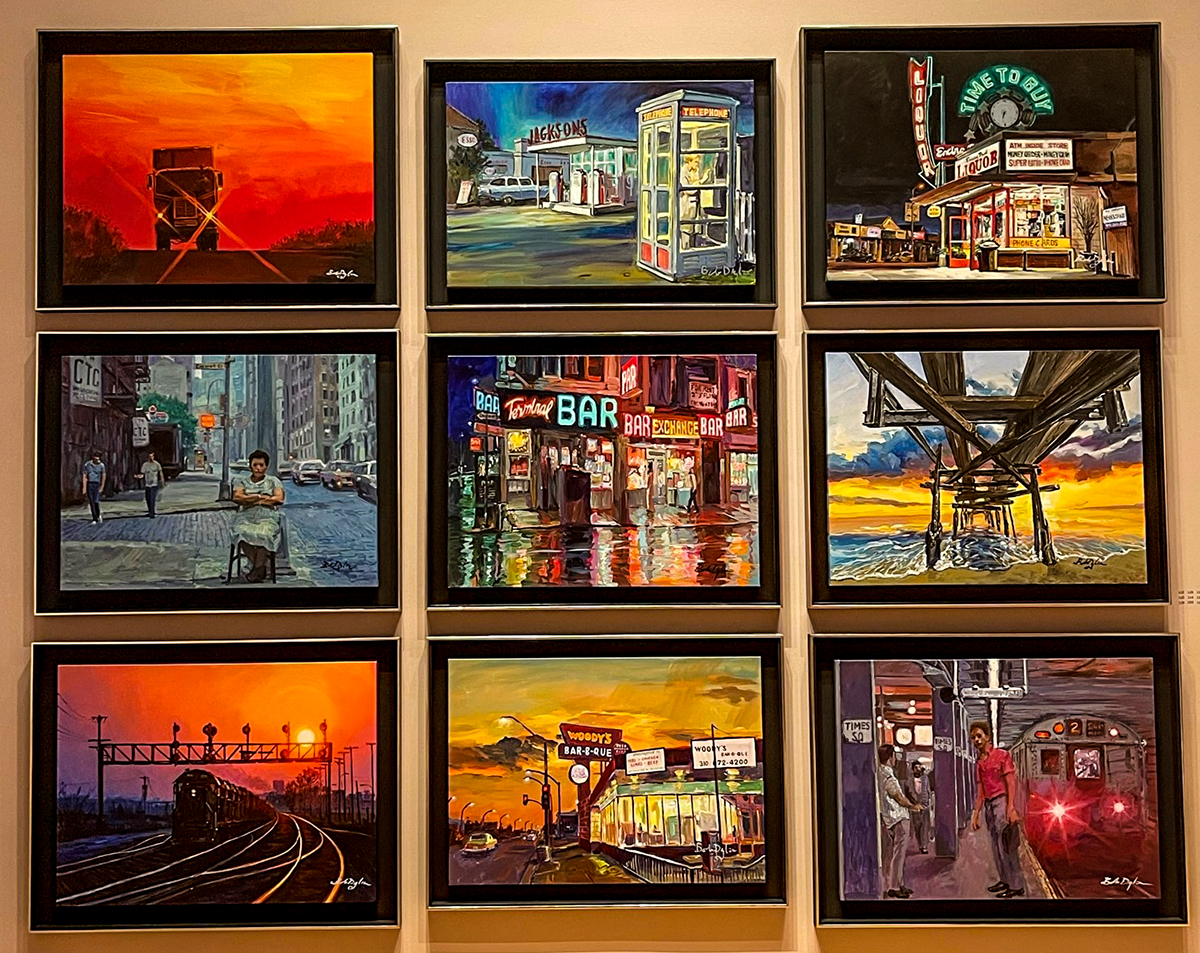
The most impressive work is a 2019 addition to the series, “Sunset-Monument Valley,” a large acrylic triptych of the Arizona landmark. A 1960 Chevy Impala convertible straddles the center-line of a two-lane road heading into a blazing orange sunset (one of many such sunsets in the exhibition)
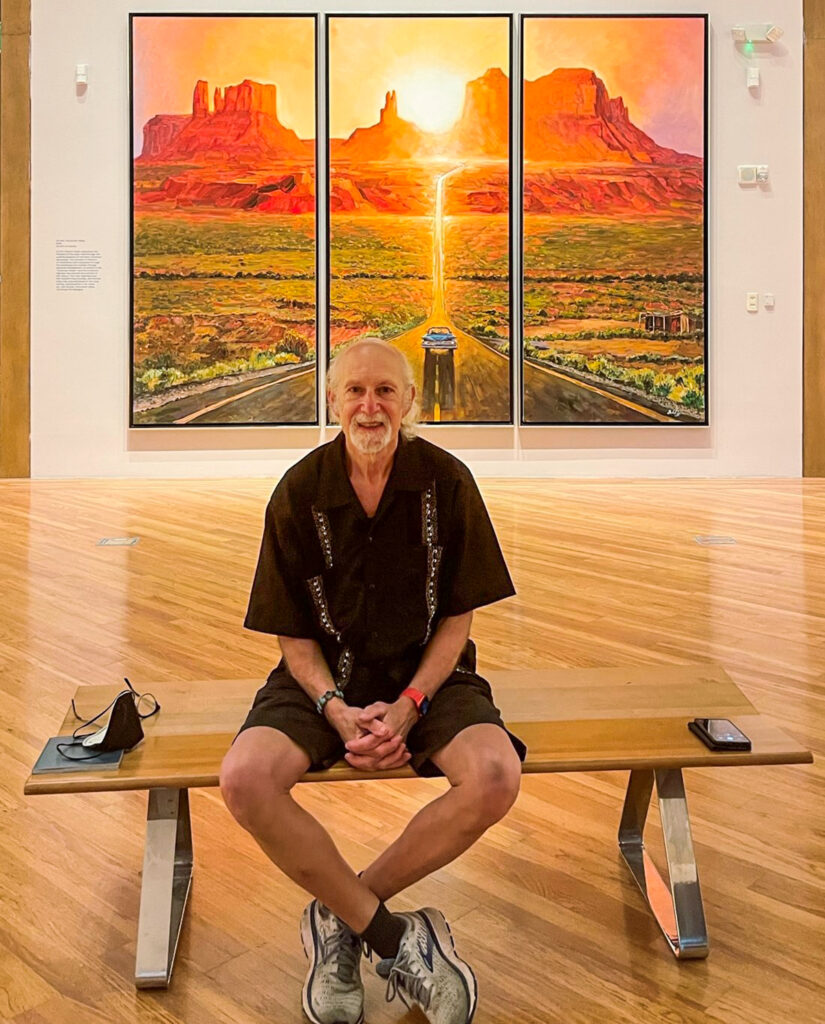
As a Nobel laureate in literature, Dylan couldn’t very well ignore the legacy of his words in creating art. So in 2018’s Mondo Scripto series, he handwrote some of his most important lyrics, packaging them with a corresponding graphite drawing. An apocalyptic storm floods Manhattan in the illustration for A Hard Rain’s A-Gonna Fall, while Mr. Tambourine Man’s ‘ancient empty streets” are represented by a cobblestone road of old Rome. Famous – or notorious – for tweaking his lyrics long after they were recorded, Dylan also takes the opportunity here to revise several songs, sometimes with entirely new verses.
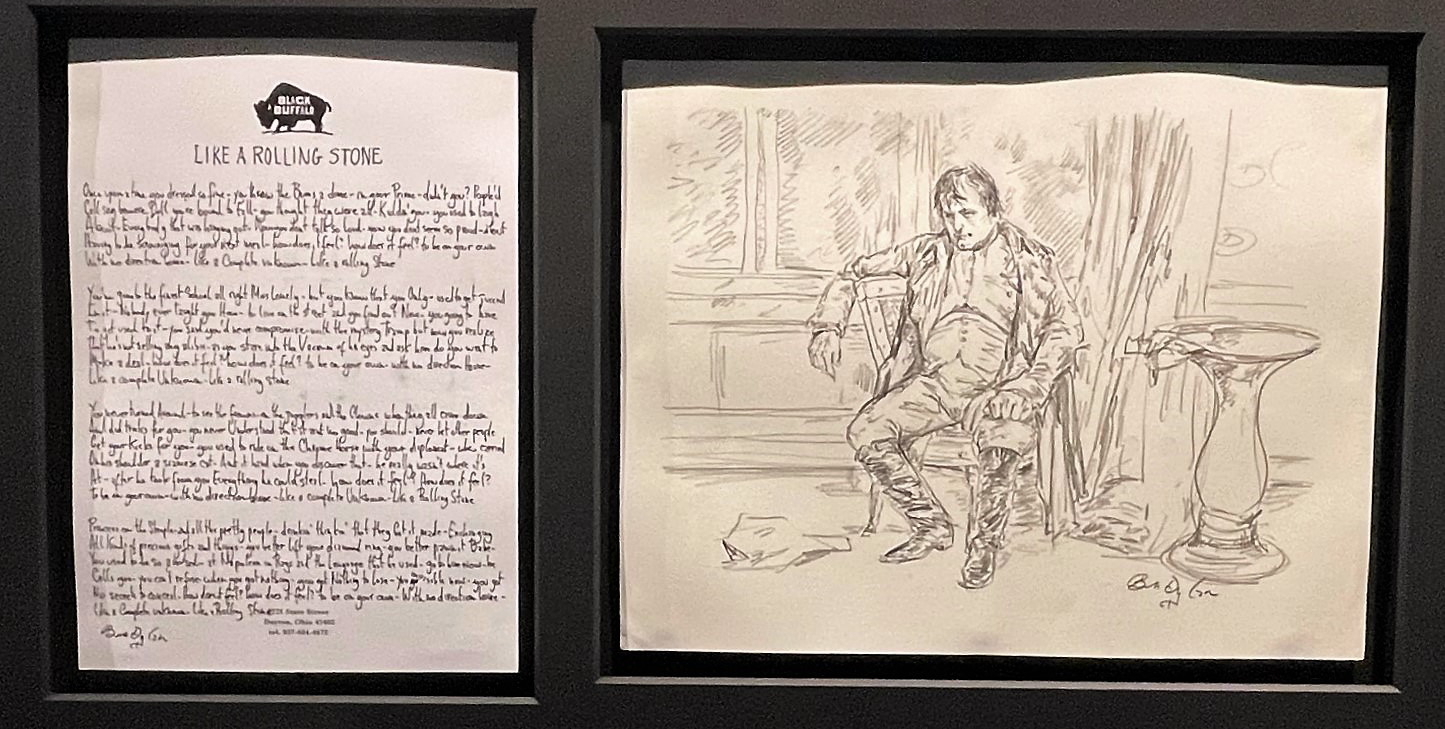
And, yes, it’s his actual handwriting, not a computer-generated font – even on the 1406-word Murder Most Foul. That 2021 song about the assassination of President Kennedy is illustrated with a drawing of a street in downtown Dallas.
“There are a lot of places I like,” Dylan wrote in his quasi-memoir Chronicles in 2004, “ but I like New Orleans better.” I first saw segments of the New Orleans Series in the Crescent City during Jazz Fest in 2016. Most are snapshots of people and places in subdued, even somber tones, but some pop with the life of America’s most musical city.
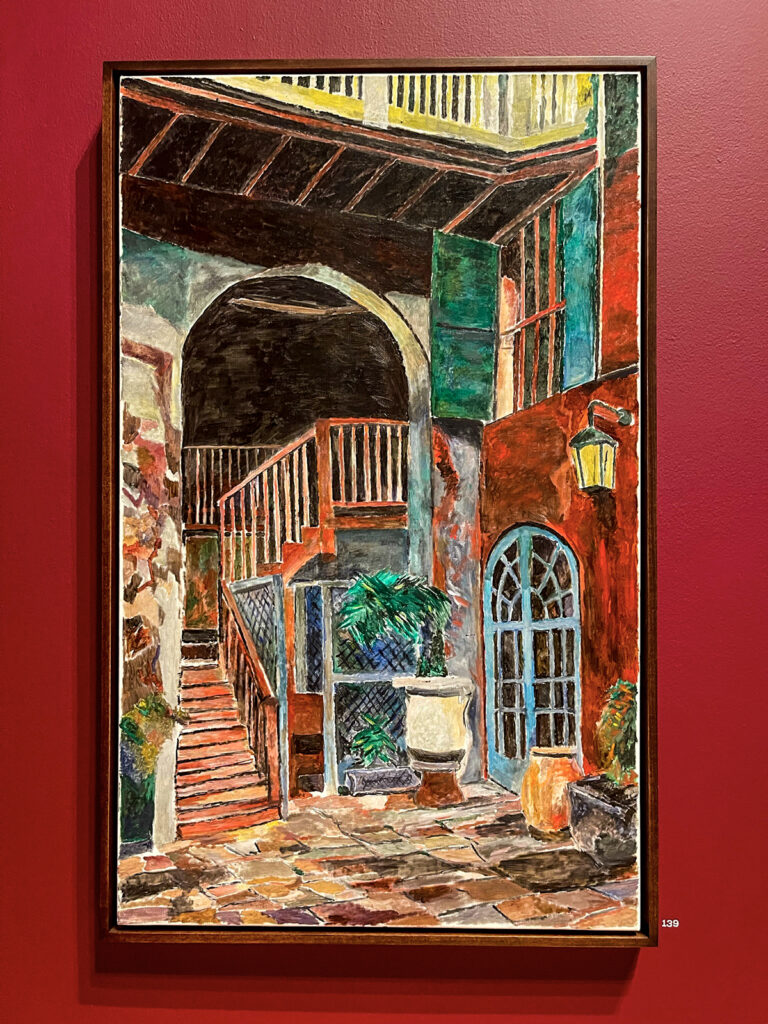
Dylan was born in Duluth, but raised in Hibbing, home of the world’s largest open-pit iron mine. About ten years ago he started honoring that heritage artistically, welding a unique series of wall hangings, gates and furniture, ten of which are on display here.
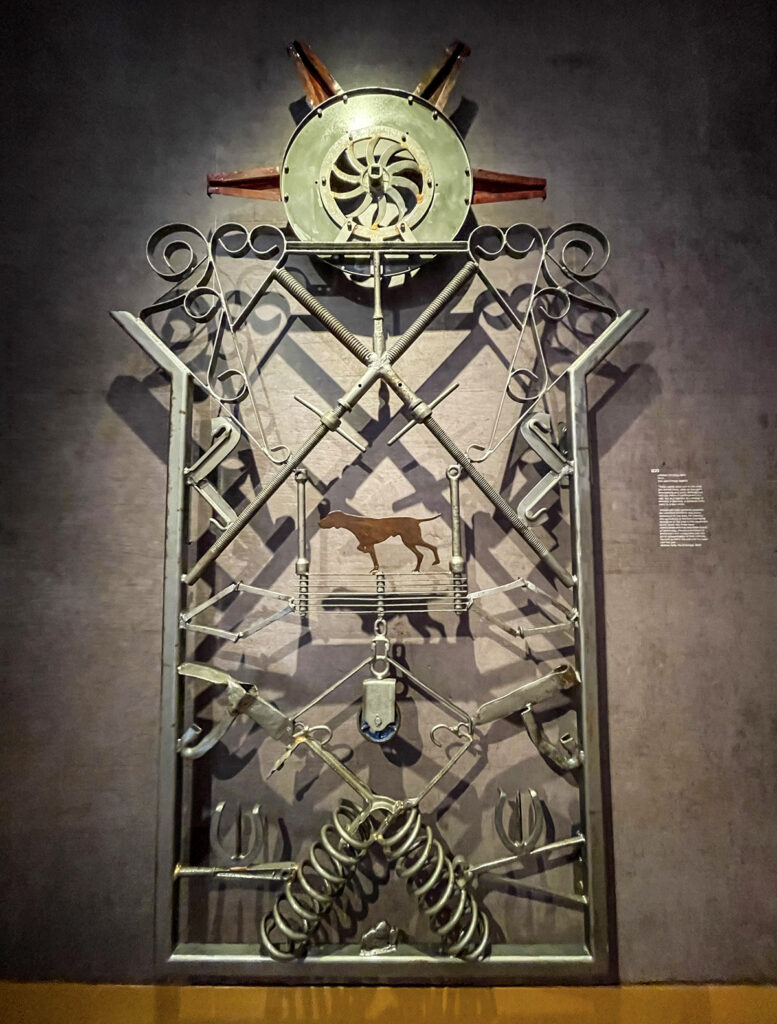
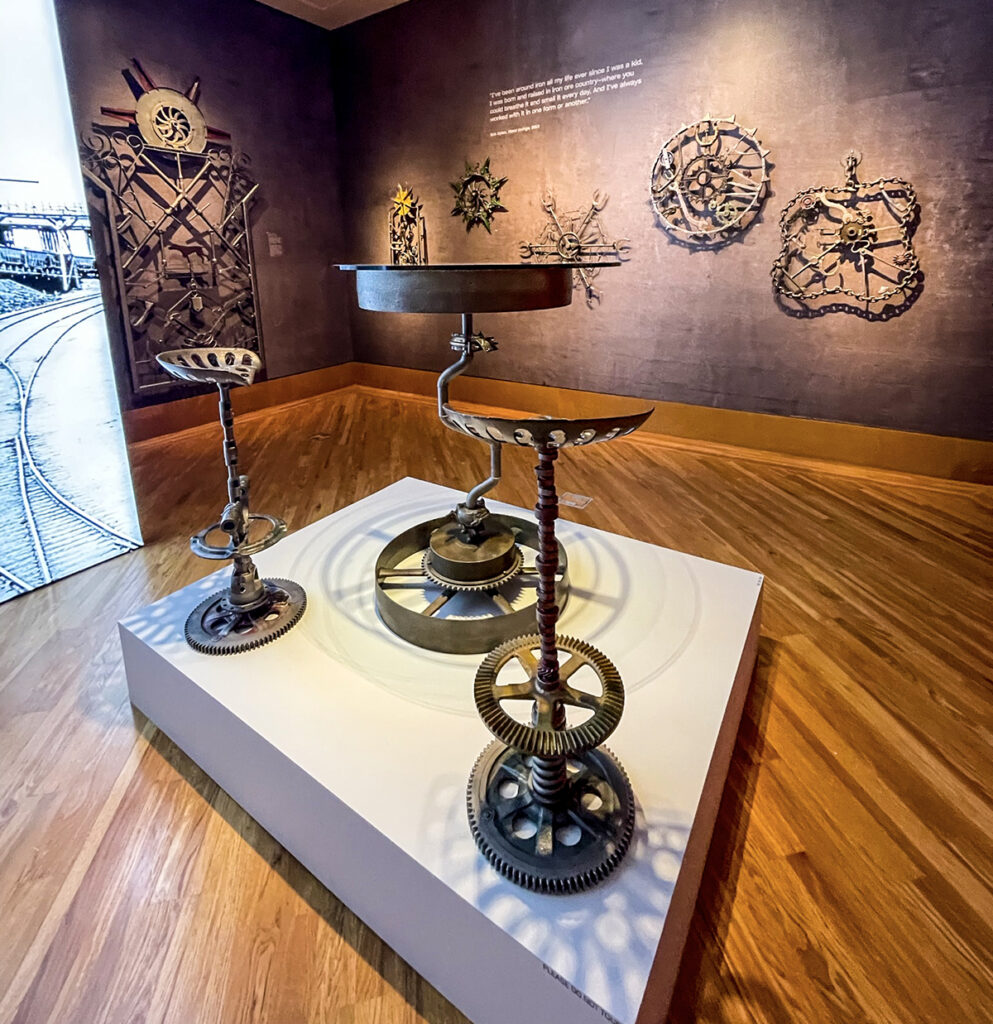
My last night, I had to follow Dylan’s advice and delve into the past – mine. My mother grew up in Miami, and her folks retired to Surfside, so here’s where I spent my childhood spring breaks as well – including in February 1964, when my mother, a former reporter for the Miami Daily News, got me and my sister through the police lines at the Fontainebleau Hotel as the Beatles passed by, close enough to touch. So I had to drive up the pulsating Collins Avenue to pay respects, first to the hotel, then Mumsie and Pops’ place on Carlyle Avenue – and then walk two blocks to pay respects where Champlain Towers South once stood.
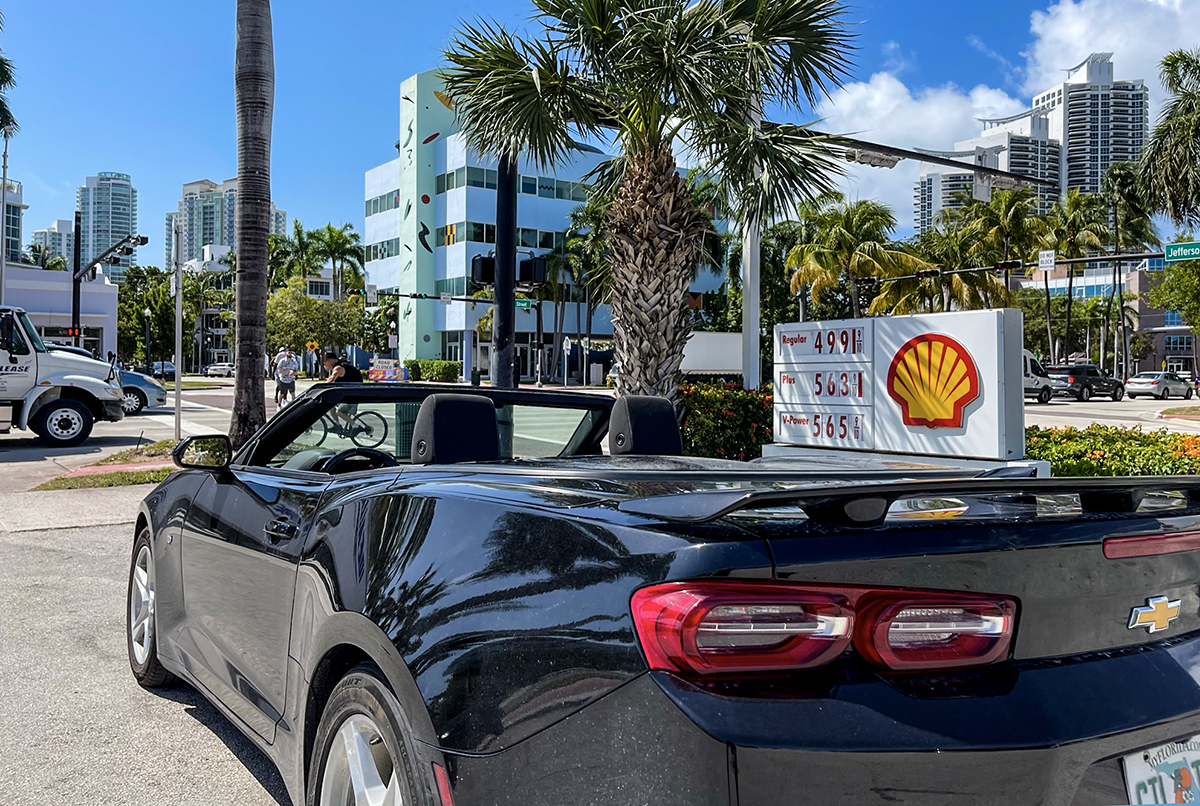
Thanks to a late check-out Wednesday, I had time for a final blast from the past – wave jumping in the Atlantic Ocean. The waves weren’t quite sufficient to body surf, but they were enough to tide me over till the end of the Wisconsin winter. Whenever that comes.

